Choose your language


Covid-19: Travel Restrictions in the Dominican Republic
Lighthouse in Santo Domingo
Photo: Leo Arturo Martinez
All information in this article was correct at the time of publishing, February 5 2021 - please double check official sources for updates
With 33 countries closing their borders to US travellers last month, US residents yearning for an overseas holiday will be glad to know international travellers are currently welcome to travel to and from the Dominican Republic.
At the moment, restrictions for foreigners in the Dominican Republic aren’t prohibitively strict, but there are some requirements, restrictions and free services you should be aware of. Here’s what to expect if you’re planning to cross the border, in or out.
If you’re travelling to the Dominican Republic
Every incoming arrival must undergo a mandatory temperature check upon arrival, and anyone with positive results will be isolated in authorized locations. Border control isn’t requiring negative test results of every traveller - officials are testing everyone with symptoms and conducting random testing of 3-15 percent of all new arrivals over the age of five (crew members are exempt).
If you’re coming from or via the UK, you must provide evidence of a negative test result obtained within three days prior to your arrival. If visitors from The U.K don’t bring their PCR results, they might be required to go through a PCR test and be isolated in a government facility.
Until February 2021, all visitors must complete either a Traveler Health Affidavit or a digital “eticket” form, a combination of the usual Customs Declaration and Embarkation/Disembarkation forms with the Traveler’s Health Affidavit. From March 1st 2021, only digital “etickets” will be accepted.
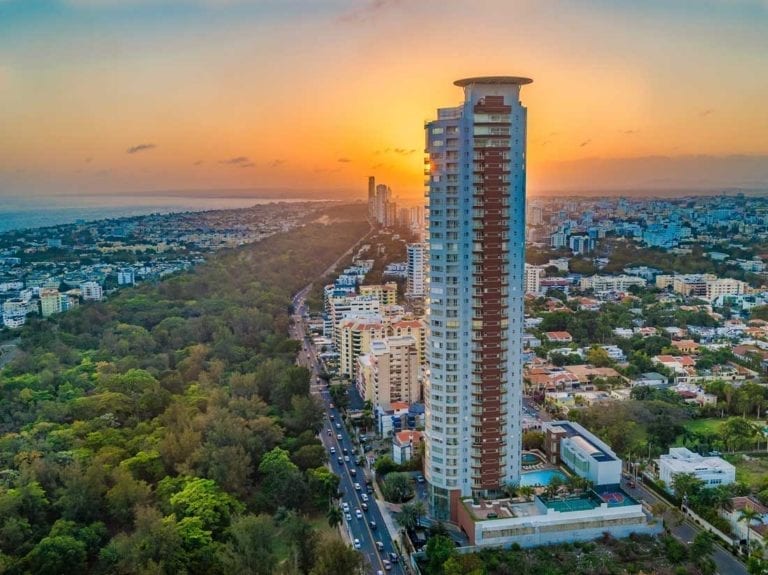
Mirador Park skyline, Santo Domingo
If you’re already in the Dominican Republic
Anyone returning to the United States from The Dominican Republic must provide evidence of a negative PCR or Covid-19 test result obtained within three days prior to re-entry. Luckily, the ministry of tourism is offering PCR tests to all international visitors staying in a hotel. This service is provided to all international travelers coming via comercial flights and staying in a hotel. Confirm with your hotel to make sure the test will be covered.
Your hotel can help you arrange an appointment before you depart back to your country of origin. Your hotel might charge a fee to arrange an appointment for you, but keep in mind tests in the Dominican Republic are currently hard to get, so arranging through your hotel might be the most effective way to ensure you get the test done before your return flight.
For international visitors arriving on commercial flights on or before March 31st and staying at a hotel, the government is providing free emergency travel assistance.
How curfews and changed capacity will affect you
If you plan to stay in a hotel or resort, you won’t feel the curfew currently in place everywhere else. Bars and restaurants are closed at 7 PM and transit is available until 10 PM from Monday to Friday. The curfew is subject to change every 28 days, and you can find up-to-date restrictions guidelines on the Dominican Ministry of Health’s website, Instagram or Twitter accounts.
Due to Covid-19, most hotels, bars and clubs in the Dominican Republic have temporarily shut their doors. As in cities and towns across the globe, hospitality businesses are having to reinvent themselves in order to survive. Most restaurants and bars that are open, are open at half capacity.
Most of the museums are closed, and some outdoor parks as well. You can walk or run through the malecon, enjoy a beer in a park or smoke a cigar on the beach. Social life and nightlife has been affected the most, so if you have your heart set on dancing til dawn in the Dominican club scene, you might want to postpone your trip.
However, if a secluded vacation at a half-empty beach resort appeals to you, the Dominican Republic might be the destination for you. The beaches are as beautiful as ever, and there’s considerably more peace and quiet than usual to be found at beachside resorts.
Written by Diego Angeles.
Published February 2021
Explore the Dominican Republic's Wildlife & Nature
A pocket guide to samaná.
Step into the outstanding Peninsula of Samana Dominican Republic, and
Explore Bahía de Las Águilas
Go glamping in Bahía de Las Águilas, a pristine paradise
Wildlife in the Dominican Republic
Step into the world of wildlife in the Dominican Republic,
Get up close with wildlife in the Sierra de Bahoruco National Park
In the Southwestern area of Hispaniola, only a couple of
Sea, Salt and Whalesong: Waiting for the Whales in Samaná
Samaná is one of the best places in the world
Your Pocket Guide to Miches
Get the latest on the pristine destination of Miches in
Hike to the Salto de Jimenoa Uno Waterfall
The Salto de Jimenoa Uno waterfall appears in the opening
Ojos Indígenas Ecological Reserve
Just minutes from Punta Cana resorts, swim in incredible Larimar-colored
8 Instagram Accounts that Will Make You Want to Visit the DR
Natural wonders, eco adventures and intimate personal diaries of daily
10 Prettiest Waterfalls in Dominican Republic
Take a look at the prettiest and largely unknown waterfalls
Subscribe to our newsletter
Get more travel inspiration, tips and exclusive offers sent straight to your inbox
I would like to get Visit Dominican Republic newsletters in my inbox
Paradise for Your Inbox
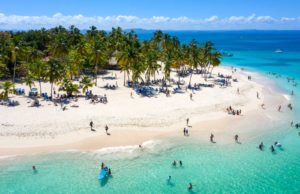
Subscribe to our newsletter for the best monthly stories and insider guides about the Dominican Republic!
- Visit Oyster on Facebook!
- Visit Oyster on Pinterest!
- Visit Oyster on Instagram!
- Visit Oyster on Twitter!
- Subscribe to stay up to date!
Yes, send me expert tips and deals!
By proceeding, you agree to our Privacy Policy and Terms of Use .
- Subtract one room 1 Rooms Add one room
- Subtract one adult 2 Adults Add one adult
- Travel Tips
- Dominican Republic
16 Things Every Traveler Should Know Before Visiting the Dominican Republic
See recent posts by Toby Orton
Beautiful beaches , amenity-packed resorts, awe-inspiring nature, incredible golf, and a vibrant culture -- these are some of the things that make the Dominican Republic one of the most-visited destinations in the Caribbean . Lured by the delights of Punta Cana and beyond, over six million people choose to vacation here each year. However, despite the paradisiacal elements, the island isn’t perfect. In fact, it made the news this year for an unusual spate of tourist deaths. With that in mind, it pays to be prepared before you visit. To help you arrive informed, here are 16 things every traveler should know before visiting the Dominican Republic .
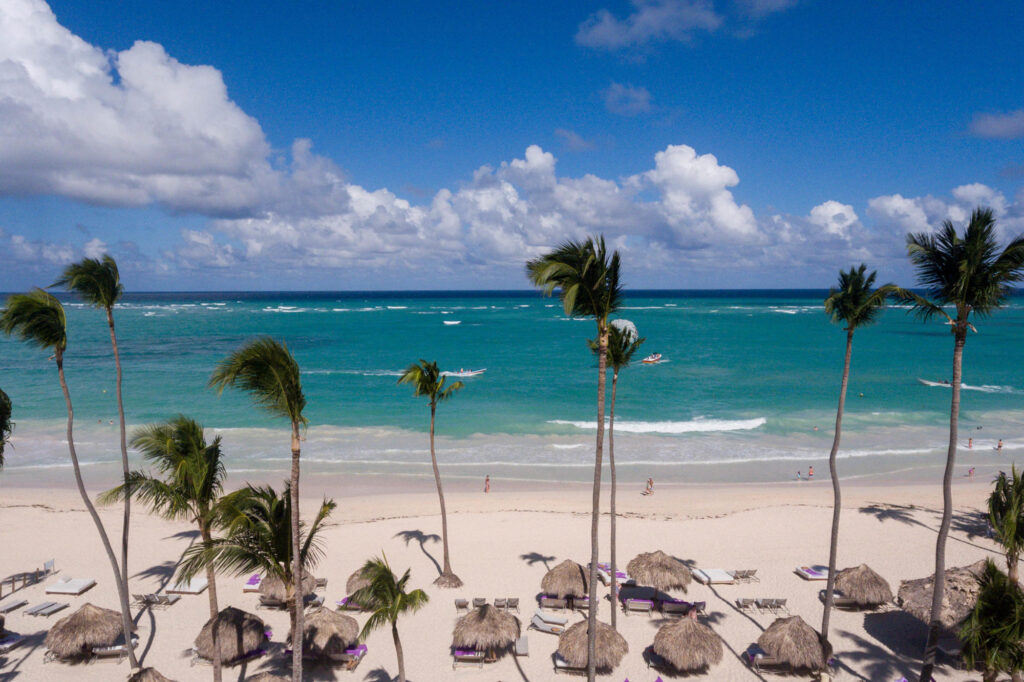
Beach at the Paradisus Punta Cana Resort/Oyster
1. Safety in the Dominican Republic is generally okay.
While the Dominican Republic has had its fair share of negative press, the country is generally safe, especially if visitors stick to tourist areas and follow the usual common sense when it comes to traveling. The spate of tourist deaths in 2019 made headlines, but the majority of people visit without experiencing any issues. The U.S. State Department ranks the Caribbean destination with a Level 2 warning (the same as France and Germany), meaning visitors should exercise increased caution. Muggings and pickpocketing are the most common complaints, so tourists should be sensible and careful not to find themselves in the wrong place at the wrong time.
2. Dominican Republic tourists should watch out for scams.
As with many other tourist destinations, the Dominican Republic has its issues with scams and hustles. From fake beggars and police to unlicensed taxis, there’s a wide variety of potential scams to avoid on the island. Also, be mindful of people trying to pick up parking charges at the beaches (parking is free).
3. Spanish is the local language in the Dominican Republic.
Spanish is the national language in the Dominican Republic, so learn a few key phrases before you arrive. English is widely spoken at the resorts, but if you choose to explore further afield, you’ll likely need to know a little Spanish to get by. Plus, you’ll feel much more comfortable engaging with people, if you can converse in their local language.
4. Visitors no longer have to pay a tourist fee upon arrival.
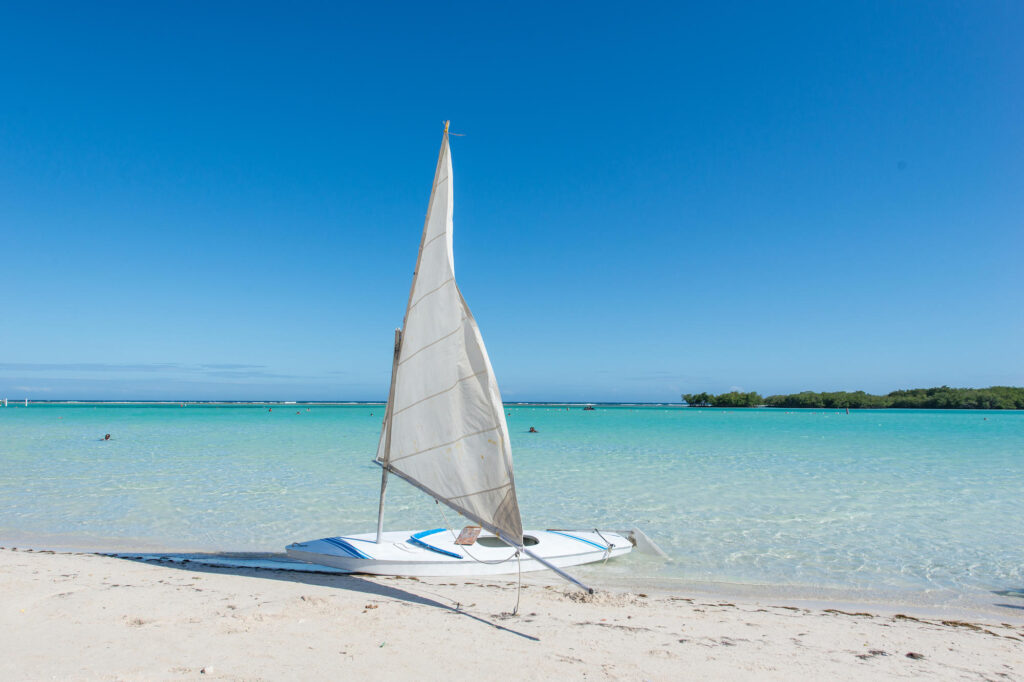
Beach at the Hotel Bellevue Dominican Bay/Oyster
Previously, many visitors to the Dominican Republic were required to pay a tourist fee upon arrival. The U.S. $10 fee has now been added onto the cost of flights, which means smoother arrivals. Yes, you still have to pay, but at least you don’t have to line up to do it.
5. The local currency in the Dominican Republic is the Dominican peso.
The Dominican peso is the local currency on the island, so exchange U.S. dollars when you arrive. You can use U.S. dollars, but in many places, you’ll likely be paying a higher price for products and services. If you plan on staying at your resort the whole time — particularly if you’re on an all-inclusive vacation — then U.S. dollars will work just fine, but you might want some local currency when venturing off the property.
6. Dominican Republic excursions should be planned carefully.
Keep in mind that many major attractions aren’t close to the main resort areas. For example, if you’re staying in Punta Cana, finding the local culture or mythical waterfalls might take a little planning. That’s not to say you shouldn’t branch out and experience what’s on offer beyond your all-inclusive resort — just don’t expect a quick 10-minute cab ride up to Monkeyland.
7. Book airport transportation to your Dominican Republic hotel in advance.
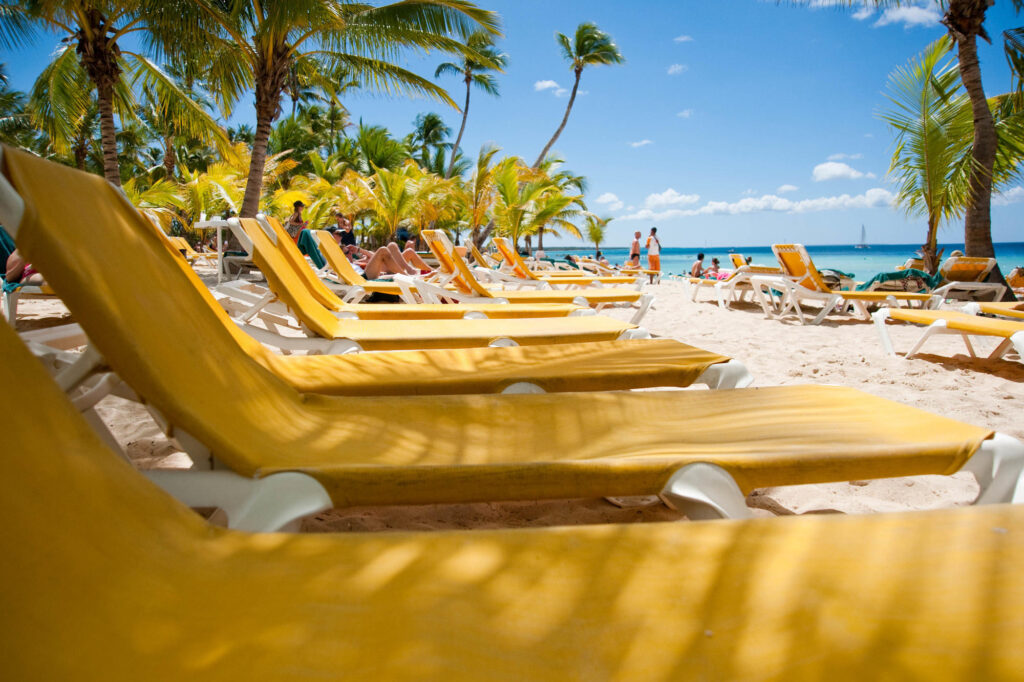
Beach Near La Romana in the Dominican Republic/Oyster
Finding your own transportation from the airport can be stressful, especially with issues like unlicensed taxis. Avoid that stress and book a car in advance. You’re likely to save on time and money, plus gain some peace of mind, with a little forward thinking.
8. Baseball is the national sport in the Dominican Republic.
Baseball is the biggest sport in the Dominican Republic, with the country providing the second-highest number of players in Major League Baseball after the U.S. If you visit in the winter (October through January) and fancy an excursion away from the beach, check out a Dominican Professional Baseball League game. Catching a game is a great way to soak up the culture and mix with local fans.
9. Be aware of sex tourism in the Dominican Republic.
Depending on where you are on the island, you might see some aspects of sex tourism . Due to the high poverty rates, prostitution has a visible presence throughout the D.R., particularly in Santo Domingo and Puerto Plata. It’s important to be aware of the issues around trafficking and prostitution, in order to gain insight into the island beyond its dreamy Caribbean image.
10. Using Uber in the Dominican Republic is a great way to avoid inflated prices.
Uber operates in Santo Domingo, Santiago, and Puerto Plata, so if you’re worried about being ripped off in a taxi, this is a great option.
11. There is such a thing as island time.
Island time is alive and well in the Dominican Republic. That means things run at their own pace, unhurried by tourists who arrive with strict routines. Expect everything from restaurant reservations to pre-booked taxis to operate with a delay — 15 to 30 minutes late is hardly considered off schedule. Just go with it — you’re on vacation, after all.
12. Locals in the Dominican Republic are welcoming.
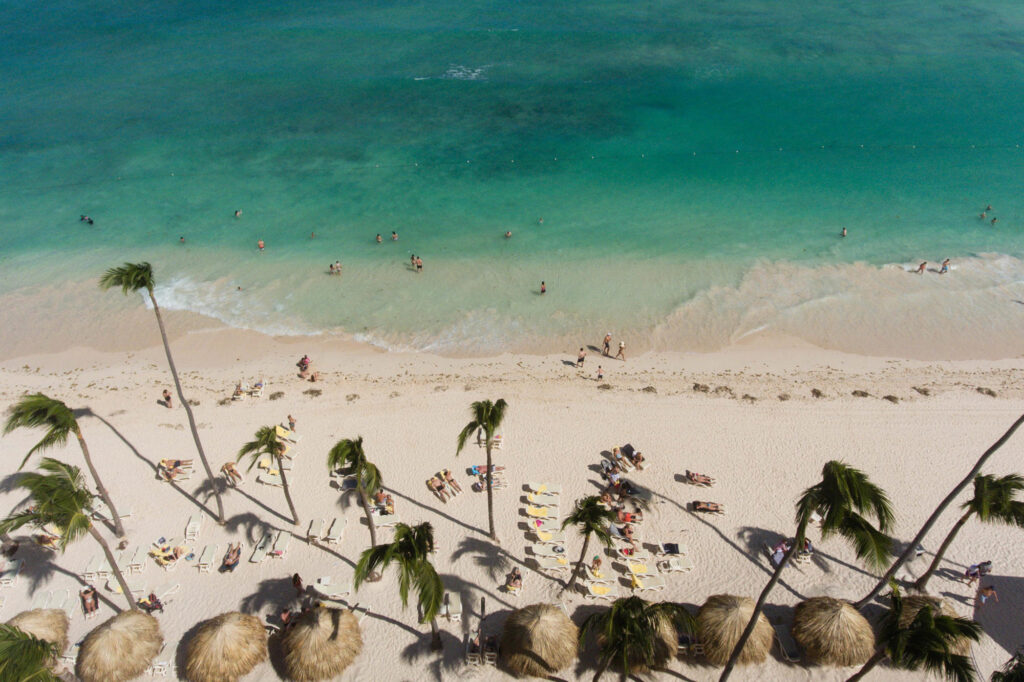
Beach at the Majestic Colonial Punta Cana/Oyster
While it’s often stories about pickpocketing that make the news, locals in the Dominican Republic are warm and friendly. In fact, their hospitality and generosity are part of what makes the island so great.
13. You can’t drink the tap water in the Dominican Republic.
Bottled water is available everywhere, so don’t even think about drinking the tap water in the D.R. Some hotels provide filtered H2O, but play it safe and stick to the branded bottled water to avoid any unpleasant illnesses.
14. You’ll have to pack more than beachwear.
If you plan on taking in the nightlife in the Dominican Republic, make sure to pack more than your standard beachwear. Dominicans take clubbing seriously, and turning up in your beach attire will make you feel slightly underdressed in many bars and clubs. You don’t have to bring anything fancy, but at the very least, leave your flip-flops at the hotel.
15. A mobile hotspot device can come in handy.
Wi-Fi is generally good in the resorts, but can be patchy in some parts of the island. That being said, you might want to get a mobile hotspot device to stay connected, especially if you plan on traveling off the property.
16. The beaches in the Dominican Republic are incredible.
If you’re visiting the Dominican Republic, chances are you want to spend some time on the beach. Luckily, the Caribbean country is home to some of the most beautiful stretches of sand in the world . From popular Bavaro Beach to Playa Rincon, which has a more undeveloped feel, there are plenty of options to choose from.
Our Top Pick for a Hotel in Punta Cana: Majestic Colonial Punta Cana
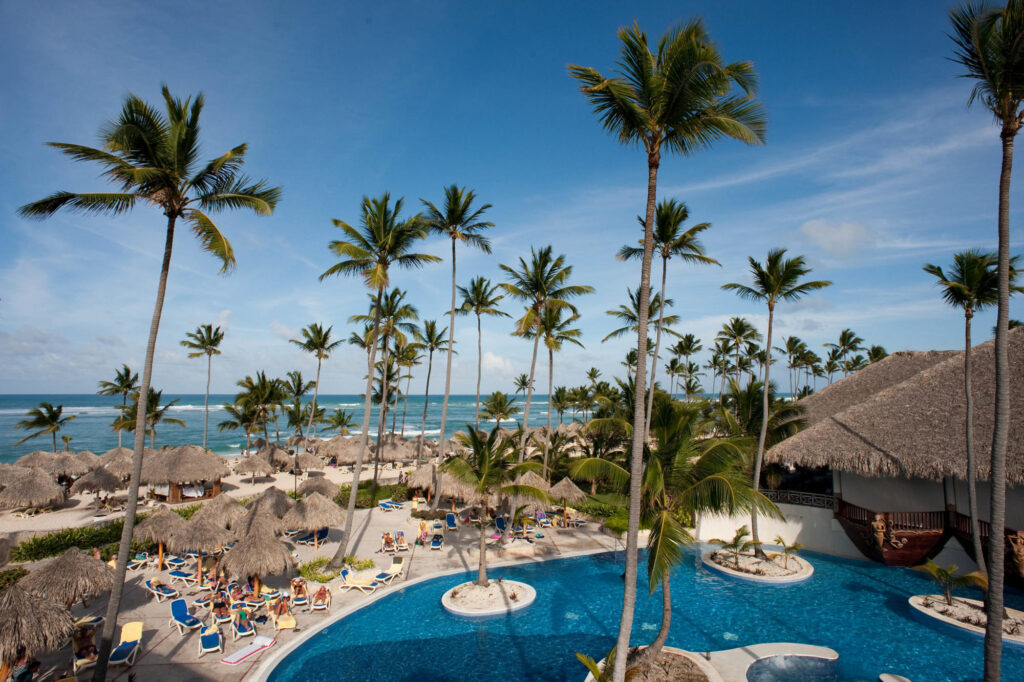
View from the Colonial Junior Suite at the Majestic Colonial Punta Cana/Oyster
Located on a beautiful stretch of Bavaro Beach, the Majestic Colonial Punta Cana is an all-inclusive property with two sections: the family-friendly side and the adults-only Colonial Club side. The 658 suites are attractive, and some have ocean views. Upgrades to swim-up suites are available. On-site amenities include eight restaurants, 11 bars, a 1,300-foot lazy river-style pool, and a pretty beach with free non-motorized water sports. A disco and casino can also be found here.
Pricing for Majestic Colonial Punta Cana
You’ll Also Like:
- The Best Time to Visit the Dominican Republic
- 6 Stellar Destinations in the Dominican Republic That Aren’t Punta Cana
- Where to Stay in the Dominican Republic for Every Budget
All products are independently selected by our writers and editors. If you buy something through our links, Oyster may earn an affiliate commission.
Top Stories

Top 11 Las Vegas Hotels on the Strip for Every Type of Traveler
By Christina Vercelletto

- Destination Cheat Sheets
Where to Go in Maine: 11 Places You Should See in Your Lifetime
By Kwin Mosby
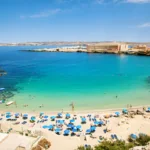
- All-Inclusive
9 European Destinations With All-Inclusive Resorts
By Stefanie Waldek
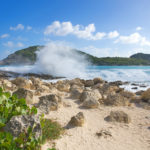
9 Beautiful Caribbean Beaches (And Where to Stay Nearby!)
By Megan Johnson

12 Cheap Alternatives to Expensive Vacation Destinations
By Kevin Brouillard
Dominican Republic Safety 2024: Is Dominican Republic Safe to Visit?
In 2022, around eight and a half million tourists visited the Dominican Republic, making it the most visited country in the Caribbean, and the fifth most visited place in the Americas.
But is the Dominican Republic as safe as it is popular? The short answer to this question is both yes and no. This is because while travel advisories consider the country only moderately safe, you’ll likely have an incident-free vacation as long as you remain cautious. Now let’s get into some details regarding the safety conditions of this beautiful Caribbean country.
Is the Dominican Republic Safe?
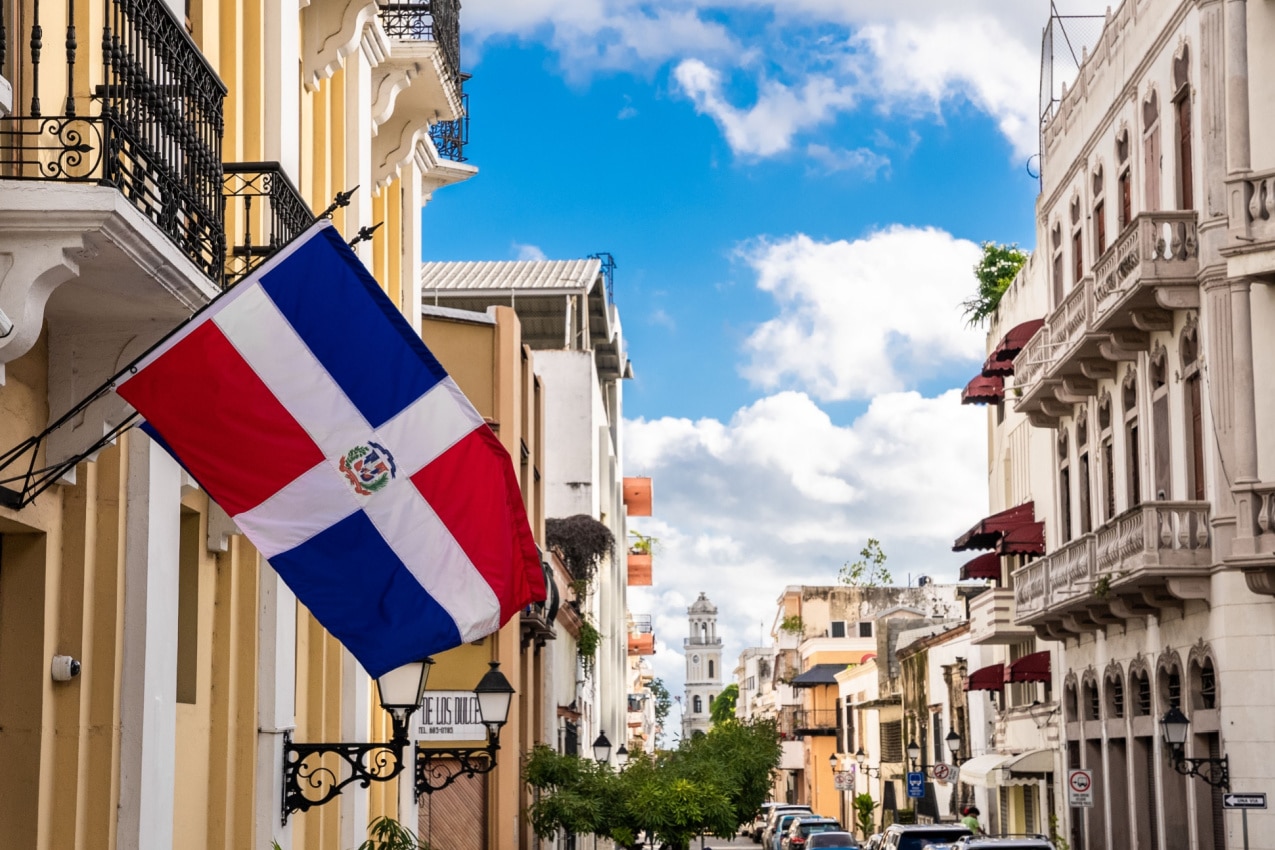
The UK travel advisory gives a well-balanced answer to this question:
“The Dominican Republic is friendly and welcoming and the vast majority of visits to the country are trouble-free. However, there is a high crime rate, ranging from opportunistic crime like bag snatching and pickpocketing to violent crime.”
Here’s a rough outlook of the country’s safety conditions:
- Travel advisory : All travel advisories consider the Dominican Republic a moderately safe location.
- Crime rate : Crime in the Dominican Republic is very high (71.34) — the main problem areas are theft, violent crime, scams, and the harassment of women.
- Dangerous areas : Stay away from La Duarte, Arroyo Hondo, Naco, Gazcue, Cristo Rey, Villa Agrícola, and Los Guandules.
- Police presence: There’s a special police force for tourists called politur .
- Natural Disasters : The Dominican Republic faces a moderate risk of hurricanes, earthquakes, and tsunamis.
- Public transport: The public buses are unsafe, but taxi companies are both safe and reliable.
- Medical care quality : It’s decent in the larger cities, but drops in quality as soon as you move toward the rural areas.
Travel Advisory for Dominican Republic
According to the US travel advisory, the Dominican Republic is classified in the level-2 safety category . That means you should exercise increased caution due to the high crime rate.
The US travel advisory ranks every country in four different categories, according to their safety level:
- Level 1: Exercise Normal Precautions
- Level 2: Exercise Increased Caution
- Level 3: Reconsider Travel
- Level 4: Do Not Travel
The other travel advisories, including the Canadian and the Australian ones, are on the same page. They cite the country’s high crime rate as the main cause for concern.
The most common crimes affecting tourists in the Dominican Republic are:
- Petty theft, including pickpocketing and bag snatching
- Assault and violent crime
- Scams and frauds
- Verbal harassment and abuse of women, including spiked food and drinks
A Comprehensive Look at Dominican Republic Crime Rates
Numbeo gives the Dominican Republic a crime rating of 71.34, which is considered a high crime index . Additionally, nearly all the individual categories for different types of crime are also either rated as very high, high, or moderate.
You can see the various scores in the table below. The data is shared by 361 contributors.
The Canadian travel advisory gives the best summary of the crime situation in the Dominican Republic: “Crime occurs in the Dominican Republic, including violent crime, especially in major cities. However, most incidents are opportunistic crimes which are the most significant threat for tourists.”
However, scams, frauds, and the harassment of women are also common.
Petty Theft
Petty theft happens all over the country, and it’s usually on the rise during the holiday season, when the country is packed with tourists. Petty theft is particularly frequent at:
- Bus stations
- Public transportation
- Airport terminals
Drive-by robberies and theft are also common in the Dominican Republic. Thieves on motorcycles or scooters drive beside unassuming tourists and snatch their bags or other belongings. They may even reach into a vehicle while waiting at a red light in traffic.
Violent Crime and Assaults
According to the Canadian travel advisory :
“ Violent crime against foreigners, including assault, occasionally occurs. Incidents take place mainly in large cities, at night or early morning. Some have been targeted in armed robberies when traveling to the Las Américas International Airport, sometimes in taxis.”
Most violent crimes are connected to organized crime rings and gangs , like the infamous Latin Kings. Gang-related violent crimes usually occur in poorer and more dangerous neighborhoods, but there have been cases of violent attacks affecting tourists, as well.
Anyhow, you should stay away from dangerous neighborhoods, since you’re much more likely to get attacked there. The most famous hotspots for crime in the country are:
- Arroyo Hondo
- Villa Agricola
- Los Guandules
Scam and Fraud
Scam and fraud are a constant threat in the Dominican Republic . Beware of:
- Criminals posing as policemen and fining tourists for made-up crimes.
- Rogue lawyers who operate near police stations and often target desperate tourists who have real problems.
- Credit card and ATM scams like cloning.
- Dating app scams and fraud that usually result in the victim getting isolated and robbed.
Verbal Harassment and Abuse of Women
According to the Australian travel advisory women are particularly at risk of harassment and assault.
The most common strategy of the perpetrators is spiking the food or drinks of victims with drugs. The drugs may be inside alcoholic or non-alcoholic drinks, snacks, chewing gum, or even cigarettes. Bars and other places of entertainment are their common territory.
Finally, dating apps also pose a danger. According to the US travel advisory :
“Several U.S. citizen travelers in the Dominican Republic have reported that they were robbed by people they met through popular online dating applications. If meeting with strangers, you should strongly consider meeting only in public places and avoiding isolated locations where crimes are most likely to occur.”
Police Presence in Dominican Republic
The Dominican Republic is protected by the Dominican National Police (Spanish: Policía Nacional Dominicana). They have nearly 32,000 officers for a population of almost nine million.
However, the Dominican police force isn’t considered to be reliable. Amongst other things, they are infamous for corruption and violent behavior , a hot topic in the media, particularly given suspicions that the police force is involved in illegal trafficking rings.
Luckily for visitors to the Dominican Republic, the country has an alternative police force that’s specifically created to protect tourists. That force is called Politur, and they’re scattered throughout the country, especially near tourist hotspots. You can easily recognize them by their uniform: white shirt and blue bermudas. They usually drive motorcycles.
Politur is highly regarded in the Dominican Republic and it’s a significant factor in maintaining its tourism industry. Recently , they received a $2 million boost and 65 new vehicles in the form of pickup trucks and motorcycles.
How to Stay Safe in the Dominican Republic
- If someone tries to rob you, hand over your personal belongings without resisting.
- Do not carry or wear valuable items that will attract attention.
- Contact the police or the hotel management if the resort or hotel staff demonstrate unwanted attention.
- Avoid secluded places, even at your resort/hotel.
- Don’t leave drinks or food unattended.
- Don’t use dating apps.
- Be careful around ATMs.
- Always ask police officers to legitimize themselves.
- Don’t use public buses.
- Stay away from dangerous areas.
- Avoid exploring the larger cities at night.
Is It Safe to Travel Solo in the Dominican Republic?
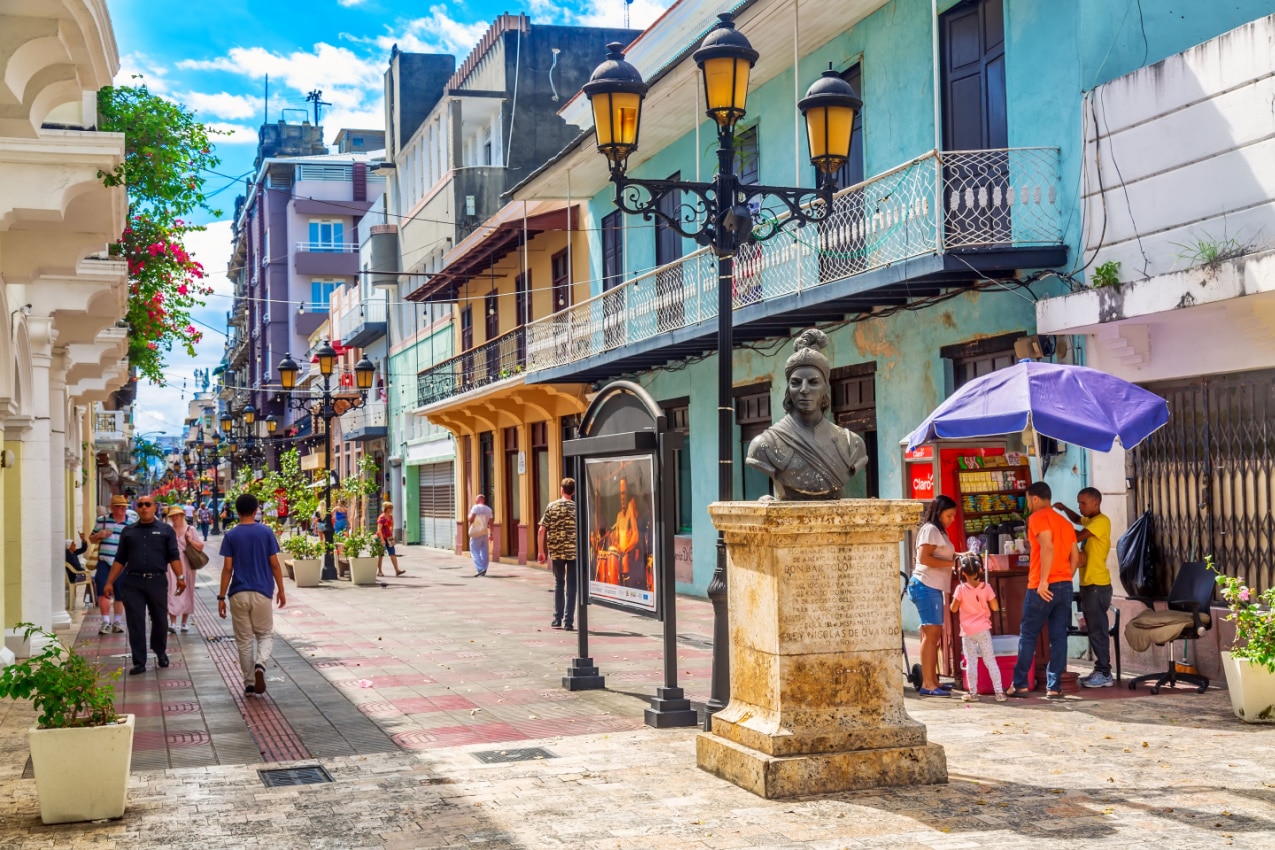
You can travel solo in the Dominican Republic if you’re well-informed and respect all the safety measures. That being said, it’s always better to travel with a group. Solo female travelers are particularly susceptible to all kinds of crime, particularly harassment and assault.
Is It Safe to Travel to the Dominican Republic as a Family?
Although it’s not the safest destination in the world, you and your family can visit the Dominican Republic as long as you are careful. This means that you should stay away from public buses, dangerous neighborhoods, and forlorn areas in the cities, and avoid going out at night. Sticking to some common sense tips can keep your mind at ease.
Perils of Nature: The Risk of Natural Disasters in the Dominican Republic
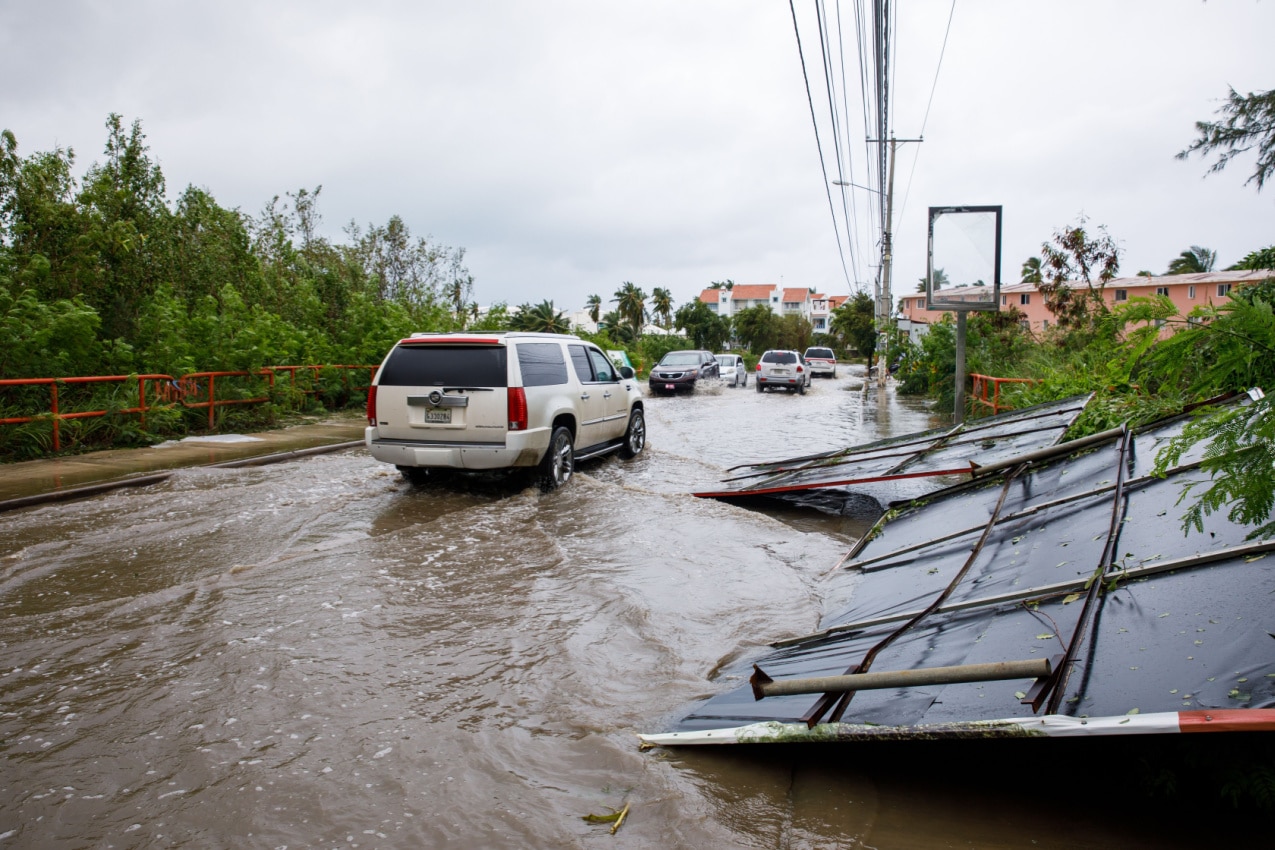
According to the Australian travel advisory , the Dominican Republic is subject to natural disasters and severe weather , such as:
- Landslides and mudslides
- Earthquakes
All of these can cause disruptions in the everyday lives of the local citizens as well as tourists’ vacations. More serious natural events can even disrupt essential services — such as water and electricity — or clog up the roads.
You have to stay cautious and prepared at all times, especially during the wet season, between May and November, when frequent rains are sure to cause landslides, mudslides, and flooding around the country.
Hurricane Information and Precautions
According to the US travel advisory , the Dominican Republic is hurricane-prone. The hurricane season begins in June and has its peak from mid-August to late October .
The coastal regions are at the highest risk of hurricanes.
On average, the Dominican Republic’s sphere of influence gets affected by at least six hurricanes annually , but only half of them directly hit the country itself.
The last hurricane to reach the country was “Franklin” on August 24, 2023 . While it was cruising on the open ocean, it was classified as a category-4 hurricane, but upon reaching the island, it lost its strength and resulted in a slightly more severe tropical storm.
The US travel advisory offers a comprehensive set of tips in case a hurricane hits the country:
- Maintain a stock of boiled or bottled water
- Store non-perishable food items
- Acquire a battery-powered radio
- Keep your vital documents (like your passport) safe and close to you
- Obtain travel insurance – it’ll certainly come in handy in the case of natural disasters
- Monitor all the local media, including the local radio and news reports
Also, it’s a good idea to follow the local and international sites that monitor hurricanes to stay up-to-date on the weather:
- Dominican National Office of Meteorology
- Dominican Emergency Operations Center
- National Hurricane Center
- Weather Channel
- Weather Underground
- Atlantic Tropical Weather Center
Earthquake and Tsunami Information and Precautions
According to the Australian travel advisory , the Dominican Republic is indeed in an earthquake-prone zone . This means that earthquakes could occur and cause destructive tsunamis. Some sources classify the earthquake hazard in the Dominican as “medium.” That means that there’s a 10% chance of a major earthquake hitting the country in the next 50 years.
On November 8, 2023 , a 5.0-magnitude earthquake affected the northwestern region of the country, near the border with Haiti. It was the strongest earthquake to hit the country that year. Fortunately, it didn’t cause any serious damage – except for two schools – or injure any people.
The UK travel advisory offers a pretty thorough procedure in case an earthquake occurs during your visit:
- Drop to the ground and take cover. Remain in this position until the tremors and the shaking stop.
- Don’t leave your position until it’s deemed completely safe.
- Stay away from street lights, buildings, and electric wires outside. Basically, avoid anything that can fall on you.
- Following the earthquake, don’t run and walk carefully. There may be aftershocks and debris.
- If you get trapped, tap on a wall or a pipe, so that rescuers can hear you.
As you probably know, stronger earthquakes may directly cause tsunamis. For example, in 1946 , an 8.1-magnitude earthquake struck the northern parts of the island and produced a very strong tsunami that resulted in over 1,000 fatalities.
Luckily, tsunamis are rare in the Dominican Republic and don’t accompany each earthquake. According to WorldData , there have only been 6 tidal waves that can be classified as tsunamis since 1751 – less than in other tsunami-prone areas.
Beware the Silent Threat: Carbon Monoxide Poisoning in Dominican Republic
The Dominican Republic is one of those rare countries where you should be wary of carbon monoxide poisoning.
According to the Washington Examiner , between 2016 and 2019, 14 people vacationing in the Dominican Republic were fatally poisoned by carbon monoxide.
It’s hard to get a figure of the total incidents resulting only from carbon monoxide poisoning. For example, a Louisiana woman lost her life in 2019: it was suspected to be carbon monoxide poisoning, but pesticide poisoning or even Legionnaire’s disease were not ruled out either.
Carbon monoxide is hard to notice since the gas is tasteless, odorless, and invisible. Longer exposure may lead to serious problems like paralysis and losing your life.
For peace of mind while staying in the Dominican Republic, your best bet is to buy a portable CO detector , which costs only around $20.
Dominican Republic Weather Patterns: What to Expect
The Dominican Republic has a tropical climate, and it’s mostly warm throughout the whole year. The period between May and October is wetter and hotter, while December to January is cooler and dryer. November and April are usually considered in-between months.
Monthly Average Temperatures and Rainy Days in Santo Domingo, Dominican Republic
Spring’s weather is sunny and dry. It’s one of the best periods to visit this country. The average temperatures never go below 68°F and higher than 89°F. Plus, there are very few rainy days per month.
Spring is the perfect time to visit the beautiful beaches of the Dominican Republic, such as Punta Cana, Bavaro, and Playa Dorada, but also to experience the excitement of the carnival in March, or the Santo Domingo de Fiesta and the Espiritu Santo Festival in May.
The beginning of summer signals the wet season in the Dominican Republic. The number of rainy days per month increases, and so do the temperatures, with a maximum daily temperature of 91°F. The weather can get stuffy and really hot, which is especially unpleasant for some.
And yet, the summer season is an undiscovered gem for many visitors who are looking for a budget trip to the island. Although the risk of a hurricane hitting the island is higher starting with August, the island is still perfectly safe during June and July.
With the coming of fall, the wet season reaches its peak. The temperatures are very high, and the number of rainy days per month is the highest in October (13 rainy days). The island is mostly tourist-free since it’s also the peak of the hurricane season.
That being said, it’s definitely the cheapest month to visit the Dominican Republic and the best time if you want to get to know the rites and customs of the local population. In September, you can experience the fantastic processions of la Dia de las Mercedes festival and the rural traditions of the Feria Ganadera El Cupey.
The tourist season begins in December. Beaches, resorts, and hotels start to fill up, and with the arrival of visitors, the prices start to rise. The temperatures start to drop after sunset, reaching 71°F, while the days are sunny, dry, and warm.
January is all about New Year celebrations, and the crowded islands brim with excitement and activity. February, on the other hand, is the official beginning of the carnival season, which attracts even more tourists.
Public Transportation Safety in Dominican Republic
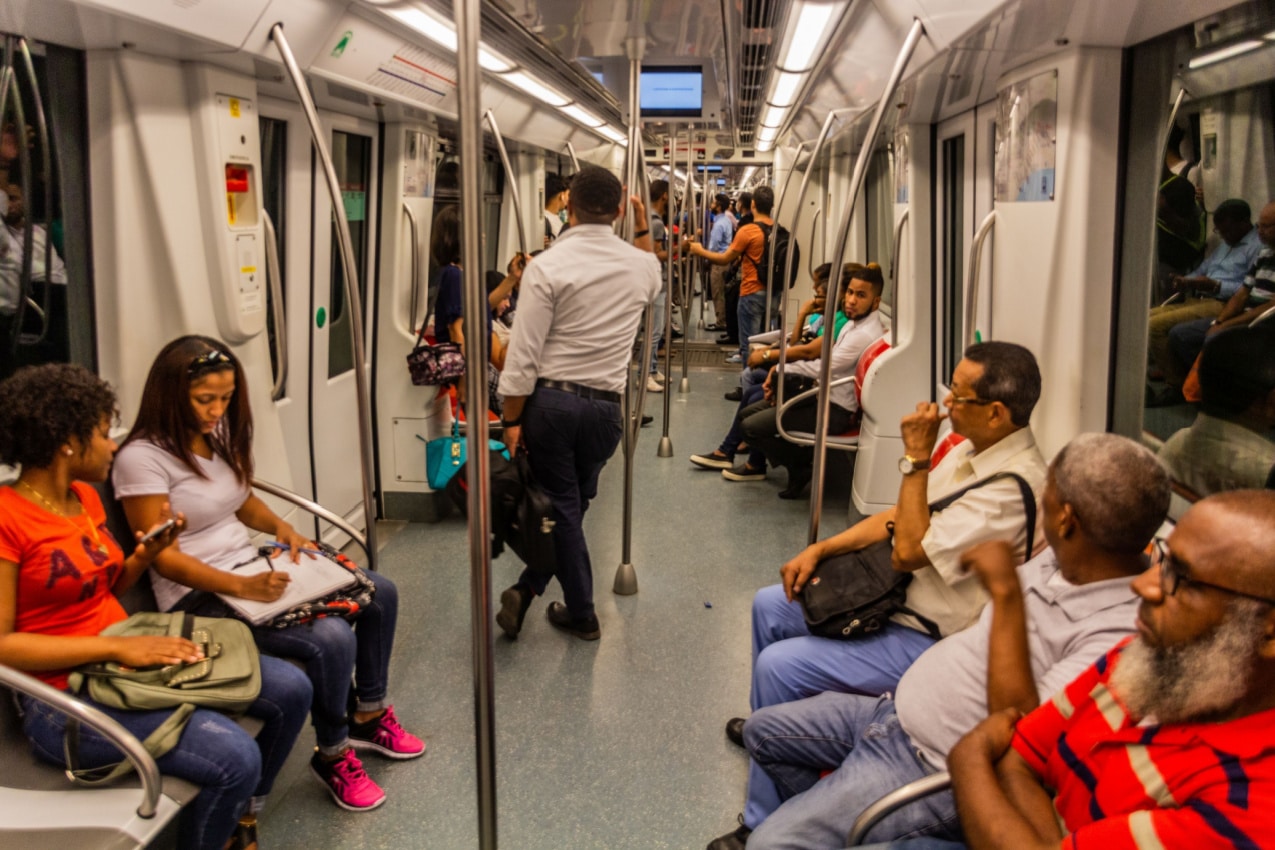
The public transport in the Dominican Republic is not safe. However, certified taxis are both reliable and safe. In terms of renting a car, keep in mind that there’s a high frequency of road accidents in the country.
According to the UK travel advisory :
- There are plenty of transport options available, like the expanded metro network in the country’s capital.
- Stay away from public buses and “carros publicos” (which are shared cars, driving along semi-fixed routes), as they’re neither safe nor secure.
- Private bus companies are completely safe , but they only provide intercity (between cities) bus services.
Public and Private Buses
The Canadian travel advisory advises against getting on public buses and gua-guas – microbuses. The latter often don’t even have doors, an additional safety concern.
Gua-guas are tiny, privately-owned buses that offer their services for either inner-city travel, or for longer destinations around the country. They are notoriously unsafe and unreliable.
Private buses, on the other hand, are quite safe and reliable. Unfortunately, they are only available for intercity travel.
Taxi Services
If you follow some simple safety tips, you’ll find that taxis are relatively safe thanks to the well-regulated taxi syndicate of the Dominican Republic .
However, make sure to only use official, marked taxis . Most of these are either beige or brown, but not always. There are over 20 official taxi companies in the country, and only official taxis can be called via telephone or a mobile app. The most famous companies are Apolo Taxi and Aero Taxi.
On the other hand, avoid using unofficial taxis at all costs . According to the Australian travel advisory, many travelers have been assaulted or robbed in unregistered taxis.
They also advise visitors not to use route taxis, better known in the Dominican Republic as carros publicos , since there’s a high chance of getting robbed. You can immediately spot carros publicos since they have no taxi markings, unlike the official taxis.
Additionally, avoid renting motorcycle taxis (motoconchos), as motor vehicle accidents are statistically more fatal than car accidents.
Lastly, keep in mind that taxis in the country are unmetered, which means that you should always negotiate the price before departure.
Renting a Car and Quality of the Roads
Finally, if you’re considering renting a car, keep in mind that the Dominican Republic has one of the highest road accident rates in the whole world. Drivers often drive while drunk and rarely respect traffic rules – including driving on the wrong side of the road! To top it all off, most vehicles are in bad condition.
According to the Canadian travel advisory , while most tourist hotspots have decent roads, less popular and less populated areas have roads of extremely poor quality.
The Quality of Medical Care in Dominican Republic
The quality of medical care in the Dominican Republic is decent in the larger cities but lacking in forlorn and rural areas. Also, private hospitals are generally better equipped and better-staffed than public medical establishments.
The Canadian travel advisory points out that private hospitals tend to overcharge for medical services. Prices might also be unstable and variable. Additionally, doctors may get a bit aggressive and pushy in their sales tactics, i.e., trying to sell you on their facility.
The best hospitals in the country, as previously stated, are located in larger cities, like Santo Domingo and its wider metropolitan area, as well as Puerto Plata. There are good hospitals in some of the smaller cities, too. Here’s a short list:
- Centro Médico UCE – Santo Domingo
- Hospital General de la Plaza de la Salud – Santo Domingo
- Hospiten Santo Domingo – Santo Domingo
- Hospital General Vinicio Calventi – Santo Domingo
- Centro Médico Bournigal – Puerto Plata
- Centro Médico Punta Cana – Punta Cana
- Hospital General de la Plaza de la Salud – Higüey
- Centro Médico Corominas – San Francisco de Macorís
- Centro Médico Cibao – Santiago
- Hospital Metropolitano de Santiago (HOMS) – Santiago
Dominican Republic, Here We Come!
You can have a great time visiting the Dominican Republic – provided that you keep your eyes open and exercise increased caution.
In short, don’t trust strangers, dating apps, public transportation, and unofficial taxis; don’t venture into dangerous or isolated areas; stay up-to-date on the weather forecast and follow safety protocols in case of natural disasters; be careful on the roads; don’t resist in case of theft; and finally, do bring a portable CO detector along with you. In case something unfortunate happens, you can rely on the police to help you out.
Basically, stick to the maxim “better safe than sorry,” and you’ll have a great trip in the Dominican Republic.
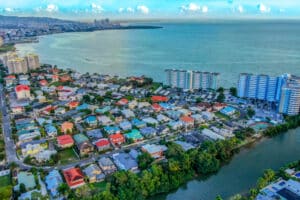
Trinidad and Tobago Safety 2024: Trinidad and Tobago Safe to Visit
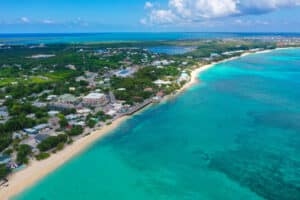
Cayman Safety 2024: Is Cayman Safe to Visit?
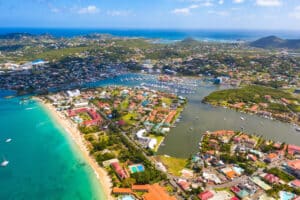
St. Lucia Safety 2024: Is St. Lucia Safe to Visit?
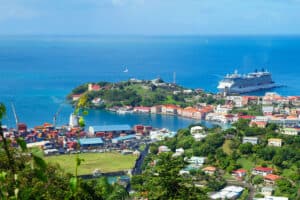
Grenada Safety 2024: Is Grenada Safe to Visit?
I moved to Punta Cana more than 7 years ago and have never felt unsafe. I have many expat friends that take public transportation buses all the time. And many use Uber we are out late several nights a week and have never had a problem. I feel safer here then I felt in the downtown of my Ontario city.
Hi Christine, thank you for reading and appreciate your first-hand feedback on the area!
Curious, I looked at Numbeo for my city, Washington, DC. It comes in at 70.86 So the DR and DC are on par. So treat the DR like any large US city. Be aware of your surroundings. No earbuds. Walk in groups.
Thank you for reading, Linette, and for your feedback.
Your email address will not be published. Required fields are marked *
Save my name, email, and website in this browser for the next time I comment.

Is It Safe to Travel to the Dominican Republic Amid the Crisis in Haiti?
As haiti endures severe unrest and political upheaval, travelers may be wondering what the situation on the ground is like in the neighboring dominican republic..
- Copy Link copied

Travelers flock to the Dominican Republic for its beauty, beaches, culture, and cuisine.
Courtesy of Jean Estrella/Unsplash
A new wave of gang violence is wreaking havoc on the streets of Haiti. Thousands of residents have been forced to flee Port-au-Prince, police stations have been set ablaze , and there is widespread call for the resignation of de facto leader Prime Minister Ariel Henry. Haiti is in the midst of one of its worst crises to date, and travelers may be wondering whether or not it’s safe to visit both Haiti and its Caribbean neighbor, the Dominican Republic.
For the past two years, Haiti has been suffering from widespread gang violence, which escalated in the aftermath of the assassination of President Jovenel Moise in 2021. Most recently, the head of the G9 Haitian gang alliance, Jimmy “Barbecue” Cherizier, made a statement in early March that if Prime Minister Henry does not resign, civil war and genocide could be on the horizon.
The U.S. State Department issued a Level 4 travel advisory for the country last July and that remains firmly in place. Level 4 is the highest advisory level, urging U.S. citizens to avoid travel to the country altogether due to the possibility of kidnapping, crime, civil unrest, and because of the country’s poor healthcare infrastructure.
While State Department travel advisories are often not the clearest indicators of whether or not a destination is safe, this time it would appear that travelers ought to proceed with extreme caution or, even better, heed the advice to the letter.
“I’d say that now is not the time to be visiting Haiti,” says Stephen Bennett, a Caribbean destination expert and cofounder of Uncommon Caribbean, an online resource for Caribbean travel. “The primary airports in the capital, Port-au-Prince, and Cap-Haitien, more than 120 miles to the north, remain closed, so flying there isn’t an option at present.”
However, Bennett confirmed that he feels it is completely safe to visit the Dominican Republic at this time and does recommend travelers keep their travel plans there. The Dominican Republic shares its western border with Haiti, although the border between the two countries remains closed with heightened security and border patrols.
The U.S. State Department last updated its travel advisory to the Dominican Republic on June 6, 2023. Since then, it remains at a Level 2 , which encourages visitors to exercise increased caution. Many other popular tourist destinations have also been ranked at a Level 2 advisory, including Denmark, Costa Rica, Turks and Caicos, France, Germany, Italy, and others.
Mark Chesnut, a travel writer who specializes in the Caribbean, just returned from a trip to the Dominican Republic, including to Santo Domingo, which is the largest city closest to the Haitian border.
“I have visited Santo Domingo and the [Dominican Republic] many times over the past 30 years and during my most recent visits to both Santo Domingo and Punta Cana, I didn’t feel any different about my sense of security,” he says. “On the Dominican Republic television, there is tons of news about the border, so I was more aware of the situation because of the news, but I didn’t have a sense of a different level of danger in the DR. The crisis was a topic of conversation among locals and hotel staff, but none of them warned about increased security measures. I didn’t feel any difference in safety related to that situation.”

Prior to the current escalation in violence, Labadee was a popular cruise port in Haiti.
Courtesy of Patrice S. Dorsainville/Unsplash
Amid Haiti travel advisory, how cruise lines and airlines are responding
Haiti, however, is a different situation.
At present, JetBlue, American Airlines, and Spirit have canceled their flights into Haiti. Sunrise Airways announced on Instagram that it will operate special flights between Cap-Haitien and Miami beginning again on March 25.
Up until last week, Royal Caribbean still had calls to Labadee on the northern coast of Haiti scheduled into its upcoming itineraries. However, the cruise line has suspended upcoming calls to the port as of March 14.
“Due to the evolving situation in Haiti, and in an abundance of caution, we’re temporarily suspending our visits to Labadee for our entire fleet,” Royal’s assistant vice president Aurora Yera-Rodriguez said in a statement. “We continue to monitor and assess the situation with our global security and intelligence team.”
Royal Caribbean Group owns Celebrity Cruises and Silversea. The port of call in Labadee is a private port accessible only to cruise passengers and employees. It features a day-use resort with multiple beaches, a zip line, and other facilities.
Bennett says that officials at Sunrise Airways, which operates regularly scheduled flights throughout the country, have expressed hope that airports will reopen soon. Once that happens, Cap-Haitien, which Sunrise serves nonstop from Miami, will begin operations for visits to Haiti in the short term.
“The city’s proximity to several of Haiti’s top visitor attractions, combined with its extended stance from the crux of the tumult in Port-au-Prince should make it a viable option more quickly,” he said. He noted that the distance between Cap-Haitien and Port-au-Prince is further than the distance from New York City to Philadelphia, for a bit of perspective.
Still, an immediate solution feels far away. According to Human Rights Watch, the country is on the brink of “total collapse .” Criminal groups hold power in the country now and have killed more than 1,100 people since the beginning of 2024, reports the United Nations. Between January 2022 and early March 2024, 13,000 people have been killed, injured, or kidnapped. Thousands of women and children have been the victims of sexual violence, and hundreds of thousands of people are displaced.
According to Reuters, the U.S. and Canadian embassies have reduced their staff , leaving only essential employees in the country, and the embassies are temporarily closed to the public. For now, travelers are forced to alter their plans to visit Haiti because getting there is impossible. In the near future, should that change, deciding whether or not it is safe to visit will depend on how the situation evolves in the coming months.

- Image gallery
- Weddings & Events
- Frequently Asked Questions
- Lopesan Hotel Group
- Online Check-In
- Travel Agencies
- Companies & Groups
- Resort Rooms
- Adults Only Club
- Unique by Lopesan
- Weddings and Events

21 May June is the Best Month to Travel with Friends to Punta Cana
June is the best month to travel with friends to punta cana.
Punta Cana is one of the most fun destinations in the world for going on holiday with friends —so much so that it has earned its place as the number one favourite among university students around the world for their end-of-year trips.
If you’re considering paying a visit to Punta Cana with your friends during the month of June, in this article we’ll give you answers to the most frequently asked questions about visiting the Caribbean, concerning the season, the weather, etc.
What’s the weather like in Punta Cana in June?
Punta Cana enjoys a year-round tropical climate, which translates into a pleasant climate in any month. The difference in temperature that can be felt from one month to another will never be more than 3-5ºC. In June, this wonderful Caribbean country enjoys a temperature of 27ºC to 30ºC on average.
As for the probability of precipitation, on average there is slightly less rain during the months of November and December. However, this fact shouldn’t influence whether you choose it as a destination or the dates of your trip, since there is always a probability of tropical rains in the Dominican Republic throughout the year.
This type of precipitation comes and goes so quickly that it won’t affect your plans at all, whether you’re enjoying a walk along the paradise-like beaches in Punta Cana or are going on one of the recommended activities or excursions in the area.
Moreover, the brief rainfall can be a real blessing when the weather is hot, as it cools down the atmosphere, reduces the feeling of humidity, and the sunny weather returns in just a few minutes .
Leisure plans in Punta Cana in June
The Dominican Republic is a country full of fun cultural and entertainment traditions. Throughout the year, there are many local festivals in the island’s different regions . Whether or not your trip coincides with one of these festivals or national events during the month of June, it’s important to know that Punta Cana offers excellent nightlife and entertainment options throughout the year.
Your choice of hotel will also be key when it comes to enjoying unique leisure experiences and evening plans. Places like the Lopesan Costa Bávaro Resort, Spa & Casino set themselves apart by always offering a great number of options for having fun and relaxing, with spaces like The Boulevard TM —an exclusive area which includes everything from a magnificent casino with a size of over 1,000 m 2 to an amphitheatre, disco, bowling alley and arcade room, among many other leisure and recreation options.
When travelling with friends, the fun is always guaranteed. If you’ve already decided on the dates of your trip to Punta Cana in June, it’s important to take these tips into account when preparing your trip with friends to this Dominican region.
How useful was this post?
Click on a star to rate it!
Average rating / 5. Vote count:
No votes so far! Be the first to rate this post.
RELATED POSTS:
The weather/climate in the dominican republic month by month, when is the best time to travel to punta cana, no comments.
Save my name, email, and website in this browser for the next time I comment.
This site uses Akismet to reduce spam. Learn how your comment data is processed .
Your browser is not supported for this experience. We recommend using Chrome, Firefox, Edge, or Safari.
- Privacy Policy
Download travel resources & information
Travel Ideas
Get travel inspiration ideas in your inbox!
Entry Requirements
Most visitors arriving to the Dominican Republic–including those from the United States, Canada, United Kingdom, the European Union, Russia, Ukraine, Kazakhstan, Mexico, many South American countries, Central America, Japan, Israel, etc. do not need a visa to enter the country.
ENTRY REQUIREMENTS FOR FOREIGNERS ENTERING THE DOMINICAN REPUBLIC AS TOURISTS
Foreigners entering the Dominican Republic as tourists must comply with the following requirements:
- Passport with a minimum validity of six (6) months.
- Air, maritime or land ticket of entrance and return.
- A permanent address in the Dominican Republic.
- Proof of sufficient economic solvency to cover their expenses during their stay in the Dominican Republic.
EXCEPTIONAL MEASURES ON THE VALIDITY OF TOURIST PASSPORTS, VALID FROM JUNE 1, 2023 TO MAY 30, 2024.
EXCEPTIONAL MEASURES FOR THE NATIONALS OF THE EUROPEAN UNION, UNITED KINGDOM, CANADA, UNITED STATES OF AMERICA, BRAZIL, CHILE, ARGENTINA, COLOMBIA AND ECUADOR.
The nationals of the countries that integrate the European Union, England, Canada, United States of America, Brazil, Chile, Argentina, Colombia and Ecuador, who enter the Dominican Republic, exclusively for tourist purposes, are authorized to do so with their valid and in force passports, and that the same remain in force during their stay and departure from the Dominican territory. This exceptional measure was implemented by the Dominican authorities as of June 1, 2023 and remains in force until May 30, 2024.
EXCEPTIONAL MEASURES FOR DIPLOMATIC OFFICIALS, PERMANENT MISSIONS, INTERNATIONAL AND INTERGOVERNMENTAL ORGANIZATIONS, ETC.
The following foreigners are exempted from the above, under the condition of reciprocity:
- Diplomatic officers and consular officials accredited in the Dominican Republic, as well as other members of Permanent or Special Diplomatic Missions of Consular Posts and their family members who, by virtue of the rules of International Law, are exempt from the obligations related to obtaining a migratory category of entry.
- Representatives and delegates, as well as the other members, and their relatives, of Permanent Missions or Delegations before the Intergovernmental Organizations with headquarters in the Dominican Republic or in International Conferences held in the Dominican Republic.
- Officials assigned to International and Intergovernmental Organizations with headquarters in the Dominican Republic and their family members, as well as holders of Dominican diplomatic and official visas.
EXCEPTIONAL MEASURES FOR NATIONALS OF THE UNITED STATES OF AMERICA WHO DO NOT MEET THE REQUIREMENTS ESTABLISHED IN THE LAW AND ITS REGULATIONS.
Without detriment to the provisions of this Resolution and pursuant to the discretionary power that the Law grants to the Director General of Migration, he may authorize the entry into the country of foreigners of U.S. nationality who do not meet the requirements established in the law and its regulations, when there are exceptional reasons of a humanitarian nature, public interest or compliance with commitments made by the Dominican Republic. Each authorization constitutes a case in point and, consequently, does not constitute a binding reference or precedent.
EXCEPTIONAL MEASURES FOR CITIZENS OF CUBAN NATIONALITY LEGALLY RESIDING IN THE UNITED STATES OF AMERICA COMING FROM THE UNITED STATES OF AMERICA
Citizens of Cuban nationality legally residing in the United States of America, coming from the United States of America, are authorized to enter the Dominican Republic as tourists, even with an expired passport for no more than twenty-four (24) months, as long as they have their “Permanent Resident Card” (also known as “Green Card”), which guarantees their legal capacity to reside permanently in the United States of America. This exceptional measure will be implemented by the Dominican authorities for an indefinite period of time, starting June 1, 2023.
ACCEPTANCE OF BOARDING OF FOREIGN PASSENGERS TO DOMINICAN TERRITORY BY AIRLINES IN ACCORDANCE WITH THE ESTABLISHED PROVISIONS.
The General Directorate of Migration shall communicate the present Resolution to the airlines authorized to operate in the Dominican territory, so that they take into consideration the provisions previously established for the entry into the national territory of the referred foreigners, taking into account their respective nationalities, the purpose of their stay and the time of permanence in the national territory. Therefore, the airlines may accept the boarding of passengers of the nationalities previously established with destination to the Dominican territory in accordance with the above provisions.
Note : Any other provision established by the Resolution contrary to the provisions herein is hereby repealed.
MEASURES FOR DOMINICAN CITIZENS HOLDING A DOMINICAN PASSPORT ARRIVING FROM OTHER COUNTRIES
The aforementioned measures do not apply to Dominican citizens holding a Dominican passport entering the Dominican Republic from another country.
ROUND TRIP FLIGHT TICKET
As of April 28, 2023, during the process of registration and verification of travel documents prior to boarding, national and foreign air operators operating to and from the Dominican Republic must ensure that all foreign passengers have an air ticket to and from the Dominican Republic (roundtrip). Dominican national passengers, as well as foreigners residing in the Dominican Republic, are exempted from this requirement.
The national and foreign air operators are responsible for the strict compliance of such requirement. Failure to comply with the above will result in the denial of entry to the Dominican Republic of foreign passengers, as well as the corresponding sanctions to national and foreign air operators, established by the General Directorate of Migration of the Dominican Republic.
E-Ticket
All foreign and Dominican passengers entering or departing the Dominican Republic on commercial flights must complete the free electronic entry and exit form at: https://eticket.migracion.gob.do
It is no longer required to fill it out 72 hours prior to the trip . It can be filled out as soon as you have your flight information, even months in advance. However, it must be filled out before arriving at the airline counter at the airport, as it is required to present it to the airline. To avoid delays at the airport, it is advised to complete the form before the trip.
If your specific home city is not shown in the form, you can choose the nearest large city in your state or province. If you are staying at a vacation rental, please ask the host to provide the complete address, including province, municipality and sector.
If you are traveling as a family , you must fill out the form with the data of all the family members who will be traveling, however, it is only necessary that a single user be created in the system and that this user fill in the data of all the members of the family that belong to that trip, up to 6 members additional to the one filling out the form (7 persons in total per form). It is not necessary for each traveler in the same family to fill out an individual form. If more than 7 people are traveling, you must fill out an additional form for the rest. Children do not fill out the Customs section, only adults. A single QR code will be generated for the family.
You can print or make a screenshot of the arrival and departure confirmation QR codes. If you need to make any changes to the E-TICKET, you can consult it with the application code that was issued when you started filling out the form and make changes.
Passengers arriving on private flights, non-commercial vessels, ferries, cruise ships, etc., do not need to fill out the E-TICKET. The physical Customs Declaration and International Embarkation/Disembarkation forms will be accepted for the aforementioned passengers.
Stay Extension
If staying beyond 30 days, expect an additional fee upon departure–determined on a sliding scale according to the total length of your stay. See the applicable fees and upload required documents here , to be paid online before departure or at the airport’s immigration section–after check-in and past security–upon departure.
For more information, please visit https://www. godominicanrepublic.com/ newsroom/coronavirus/ where you will be able to find all relevant information about the measures that are being implemented in the country’s tourism industry.
The Dominican Republic issues tourist, business, work, student, and residency visas. Tourist visas can be issued for one or several entries. Any person, regardless of their nationality, can visit Dominican Republic if they are a legal resident of or, if they have one of the following valid visas in their passport: United States, Canada, United Kingdom or Schengen. Travelers who do not have a passport or visa from countries listed above or from other authorized countries will need to apply for a visa. To issue a visa the passport needs to have a validity of at least six (6) months.
The Dominican Ministry of Foreign Affairs is the institution that issues visas. They have a chat line available in English and Spanish, where you may contact them for specific visa questions or for other inquiries: https://mirex.gob.do/en/
Click HERE to check if your country requires a tourist visa.
See list of Dominican consulates abroad here . Please make sure to always check for updated requirements before traveling.
The departure tax is US$20. It is already included in your airline ticket fare.
Be sure to always check for up-to-date requirements before traveling.
You are allowed to bring the following items into the Dominican Republic:
- A maximum of 20 packs of cigarettes, 25 cigars, or 200 grams of tobacco.
- Up to three (3) liters in total of wine, beer, rum, whiskey, or liquor.
- You may also bring in gifts of a value of up to US$500 (five hundred United States Dollars) once every three months.
- Medicines for personal use, in quantities that justify the exclusive use of the passenger. In the case of medicines that contain psychotropic substances, you must present the prescription for their use.
Click HERE and HERE for more information.
Yellow Fever Vaccine
IS THE YELLOW FEVER VACCINE REQUIRED FOR PASSENGERS COMING FROM BRAZIL? All passengers arriving in the Dominican Republic from the Brazilian states of Espiritu Santo, Minas Gerais, Rio de Janeiro, and São Paulo, must present their International Certificate of Vaccination or Prophylaxis (CIVP) showing proof of vaccination against yellow fever at least 10 days prior to their arrival in the country.
Exempt from this provision are children under 10 months of age, pregnant women and travelers who have only transited for a period of less than 12 hours at an airport in any of the Brazilian states mentioned above. Any person who has a contraindication to the vaccine must present a medical certificate justifying it.
IS THE YELLOW FEVER VACCINE REQUIRED FOR PASSENGERS AND CREW MEMBERS COMING FROM THE BOLIVARIAN REPUBLIC OF VENEZUELA? As of October 15, 2021, all passengers and crew members arriving to the Dominican Republic from the Bolivarian Republic of Venezuela must present the Vaccination Card, evidencing that they have been vaccinated against yellow fever. This measure also applies to all passengers coming from the Bolivarian Republic of Venezuela arriving to the Dominican Republic from another country, and for those who have been in the Bolivarian Republic of Venezuela in the last 14 days or less. This measure applies to all passengers aged one (1) or over.
Malburg Virus
SUSPENSION OF ENTRY OF PASSENGERS AND CREW FROM THE REPUBLIC OF EQUATORIAL GUINEA DUE TO MALBURG VIRUS. As of February 21, 2023, the entry into the Dominican Republic of passengers and crew coming from the Republic of Equatorial Guinea is suspended, due to the sanitary alert declared in said country for the Marburg virus.
This measure also applies to all passengers and crew coming from a third country that have been in the Republic of Equatorial Guinea since February 8, 2023, as well as transit passengers and minors.
This measure may be revised, rescinded, or extended by the Dominican Civil Aviation Board, according to updates received on the health alert issued by the Republic of Equatorial Guinea.
Air & Sea Travel
Getting around, getting married, maps & routes, places to stay, travel tips.
Security Alert May 17, 2024
Worldwide caution, update may 10, 2024, information for u.s. citizens in the middle east.
- Travel Advisories |
- Contact Us |
- MyTravelGov |
Find U.S. Embassies & Consulates
Travel.state.gov, congressional liaison, special issuance agency, u.s. passports, international travel, intercountry adoption, international parental child abduction, records and authentications, popular links, travel advisories, mytravelgov, stay connected, legal resources, legal information, info for u.s. law enforcement, replace or certify documents.
Share this page:
Dominican Republic Travel Advisory
Travel advisory june 6, 2023, dominican republic - level 2: exercise increased caution.
Reissued with updates to health information.
Exercise increased caution in the Dominican Republic due to crime.
Country Summary: Violent crime, including armed robbery, homicide and sexual assault is a concern throughout the Dominican Republic. The development of a professional tourist police corps, institution of a 911 system in many parts of the country, and a concentration of resources in resort areas means these tend to be better policed than urban areas like Santo Domingo. The wide availability of weapons, the use and trade of illicit drugs, and a weak criminal justice system contribute to the high level of criminality on the broader scale.
Read the country information page for additional information on travel to the Dominican Republic.
If you decide to travel to the Dominican Republic:
- Be aware of your surroundings.
- Do not physically resist any robbery attempt.
- Do not display signs of wealth, such as wearing expensive watches or jewelry.
- Follow the advice of resort and tour operators regarding local safety and security concerns.
- Enroll in the Smart Traveler Enrollment Program (STEP) to receive Alerts and make it easier to locate you in an emergency.
- Follow the Department of State on Facebook and Twitter .
- Review the Country Security Report for the Dominican Republic.
- Prepare a contingency plan for emergency situations. Review the Traveler’s Checklist .
- Visit the CDC page for the latest Travel Health Information related to your travel.
Travel Advisory Levels
Assistance for u.s. citizens, dominican republic map, search for travel advisories, external link.
You are about to leave travel.state.gov for an external website that is not maintained by the U.S. Department of State.
Links to external websites are provided as a convenience and should not be construed as an endorsement by the U.S. Department of State of the views or products contained therein. If you wish to remain on travel.state.gov, click the "cancel" message.
You are about to visit:
You are using an outdated browser. Upgrade your browser today or install Google Chrome Frame to better experience this site.
Dominican Republic Traveler View
Travel health notices, vaccines and medicines, non-vaccine-preventable diseases, stay healthy and safe.
- Packing List
After Your Trip
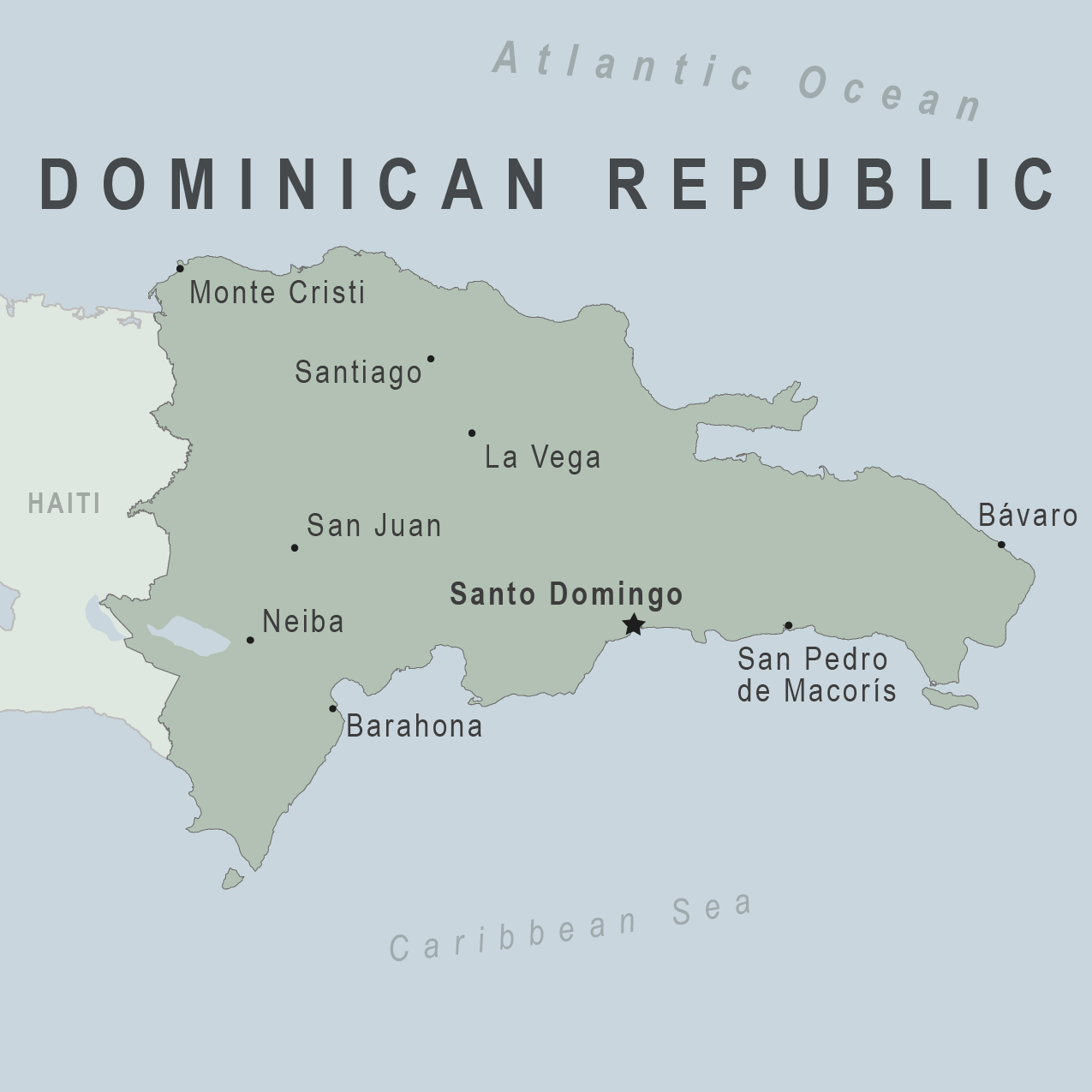
There are no notices currently in effect for Dominican Republic.
⇧ Top
Check the vaccines and medicines list and visit your doctor at least a month before your trip to get vaccines or medicines you may need. If you or your doctor need help finding a location that provides certain vaccines or medicines, visit the Find a Clinic page.
Routine vaccines
Recommendations.
Make sure you are up-to-date on all routine vaccines before every trip. Some of these vaccines include
- Chickenpox (Varicella)
- Diphtheria-Tetanus-Pertussis
- Flu (influenza)
- Measles-Mumps-Rubella (MMR)
Immunization schedules
All eligible travelers should be up to date with their COVID-19 vaccines. Please see Your COVID-19 Vaccination for more information.
COVID-19 vaccine
Areas of active cholera transmission are localized to the province of Barahona (last case reported 6-9 months ago) in the Dominican Republic. Cholera is rare in travelers. Certain factors may increase the risk of getting cholera or having severe disease ( more information ). Avoiding unsafe food and water and washing your hands can also help prevent cholera.
Vaccination may be considered for children and adults who are traveling to areas of active cholera transmission.
Hepatitis A
Recommended for unvaccinated travelers one year old or older going to the Dominican Republic.
Infants 6 to 11 months old should also be vaccinated against Hepatitis A. The dose does not count toward the routine 2-dose series.
Travelers allergic to a vaccine component or who are younger than 6 months should receive a single dose of immune globulin, which provides effective protection for up to 2 months depending on dosage given.
Unvaccinated travelers who are over 40 years old, immunocompromised, or have chronic medical conditions planning to depart to a risk area in less than 2 weeks should get the initial dose of vaccine and at the same appointment receive immune globulin.
Hepatitis A - CDC Yellow Book
Dosing info - Hep A
Hepatitis B
Recommended for unvaccinated travelers younger than 60 years old traveling to the Dominican Republic. Unvaccinated travelers 60 years and older may get vaccinated before traveling to the Dominican Republic.
Hepatitis B - CDC Yellow Book
Dosing info - Hep B
CDC recommends that travelers going to certain areas of the Dominican Republic take prescription medicine to prevent malaria. Depending on the medicine you take, you will need to start taking this medicine multiple days before your trip, as well as during and after your trip. Talk to your doctor about which malaria medication you should take.
Find country-specific information about malaria.
Malaria - CDC Yellow Book
Considerations when choosing a drug for malaria prophylaxis (CDC Yellow Book)
Malaria information for the Dominican Republic.
Cases of measles are on the rise worldwide. Travelers are at risk of measles if they have not been fully vaccinated at least two weeks prior to departure, or have not had measles in the past, and travel internationally to areas where measles is spreading.
All international travelers should be fully vaccinated against measles with the measles-mumps-rubella (MMR) vaccine, including an early dose for infants 6–11 months, according to CDC’s measles vaccination recommendations for international travel .
Measles (Rubeola) - CDC Yellow Book
Rabid dogs are commonly found in the Dominican Republic. However, if you are bitten or scratched by a dog or other mammal while in the Dominican Republic, rabies treatment is often available.
Consider rabies vaccination before your trip if your activities mean you will be around dogs or wildlife.
Travelers more likely to encounter rabid animals include
- Campers, adventure travelers, or cave explorers (spelunkers)
- Veterinarians, animal handlers, field biologists, or laboratory workers handling animal specimens
- Visitors to rural areas
Since children are more likely to be bitten or scratched by a dog or other animals, consider rabies vaccination for children traveling to the Dominican Republic.
Rabies - CDC Yellow Book
Recommended for most travelers, especially those staying with friends or relatives or visiting smaller cities or rural areas.
Typhoid - CDC Yellow Book
Dosing info - Typhoid
Yellow Fever
Required for travelers ≥1 year old arriving from the following states in Brazil: Espírito Santo, Mina Gerais, Rio de Janeiro, São Paulo; this includes >12-hour airport transits or layovers in any of these states
Yellow Fever - CDC Yellow Book
Avoid contaminated water
Leptospirosis
How most people get sick (most common modes of transmission)
- Touching urine or other body fluids from an animal infected with leptospirosis
- Swimming or wading in urine-contaminated fresh water, or contact with urine-contaminated mud
- Drinking water or eating food contaminated with animal urine
- Avoid contaminated water and soil
Clinical Guidance
Avoid bug bites.
- Mosquito bite
- Avoid Bug Bites
Leishmaniasis
- Sand fly bite
- An infected pregnant woman can spread it to her unborn baby
Airborne & droplet
- Breathing in air or accidentally eating food contaminated with the urine, droppings, or saliva of infected rodents
- Bite from an infected rodent
- Less commonly, being around someone sick with hantavirus (only occurs with Andes virus)
- Avoid rodents and areas where they live
- Avoid sick people
Tuberculosis (TB)
- Breathe in TB bacteria that is in the air from an infected and contagious person coughing, speaking, or singing.
Learn actions you can take to stay healthy and safe on your trip. Vaccines cannot protect you from many diseases in the Dominican Republic, so your behaviors are important.
Eat and drink safely
Food and water standards around the world vary based on the destination. Standards may also differ within a country and risk may change depending on activity type (e.g., hiking versus business trip). You can learn more about safe food and drink choices when traveling by accessing the resources below.
- Choose Safe Food and Drinks When Traveling
- Water Treatment Options When Hiking, Camping or Traveling
- Global Water, Sanitation and Hygiene | Healthy Water
- Avoid Contaminated Water During Travel
You can also visit the Department of State Country Information Pages for additional information about food and water safety.
Prevent bug bites
Bugs (like mosquitoes, ticks, and fleas) can spread a number of diseases in the Dominican Republic. Many of these diseases cannot be prevented with a vaccine or medicine. You can reduce your risk by taking steps to prevent bug bites.
What can I do to prevent bug bites?
- Cover exposed skin by wearing long-sleeved shirts, long pants, and hats.
- Use an appropriate insect repellent (see below).
- Use permethrin-treated clothing and gear (such as boots, pants, socks, and tents). Do not use permethrin directly on skin.
- Stay and sleep in air-conditioned or screened rooms.
- Use a bed net if the area where you are sleeping is exposed to the outdoors.
What type of insect repellent should I use?
- FOR PROTECTION AGAINST TICKS AND MOSQUITOES: Use a repellent that contains 20% or more DEET for protection that lasts up to several hours.
- Picaridin (also known as KBR 3023, Bayrepel, and icaridin)
- Oil of lemon eucalyptus (OLE) or para-menthane-diol (PMD)
- 2-undecanone
- Always use insect repellent as directed.
What should I do if I am bitten by bugs?
- Avoid scratching bug bites, and apply hydrocortisone cream or calamine lotion to reduce the itching.
- Check your entire body for ticks after outdoor activity. Be sure to remove ticks properly.
What can I do to avoid bed bugs?
Although bed bugs do not carry disease, they are an annoyance. See our information page about avoiding bug bites for some easy tips to avoid them. For more information on bed bugs, see Bed Bugs .
For more detailed information on avoiding bug bites, see Avoid Bug Bites .
Stay safe outdoors
If your travel plans in the Dominican Republic include outdoor activities, take these steps to stay safe and healthy during your trip.
- Stay alert to changing weather conditions and adjust your plans if conditions become unsafe.
- Prepare for activities by wearing the right clothes and packing protective items, such as bug spray, sunscreen, and a basic first aid kit.
- Consider learning basic first aid and CPR before travel. Bring a travel health kit with items appropriate for your activities.
- If you are outside for many hours in heat, eat salty snacks and drink water to stay hydrated and replace salt lost through sweating.
- Protect yourself from UV radiation : use sunscreen with an SPF of at least 15, wear protective clothing, and seek shade during the hottest time of day (10 a.m.–4 p.m.).
- Be especially careful during summer months and at high elevation. Because sunlight reflects off snow, sand, and water, sun exposure may be increased during activities like skiing, swimming, and sailing.
- Very cold temperatures can be dangerous. Dress in layers and cover heads, hands, and feet properly if you are visiting a cold location.
Stay safe around water
- Swim only in designated swimming areas. Obey lifeguards and warning flags on beaches.
- Practice safe boating—follow all boating safety laws, do not drink alcohol if driving a boat, and always wear a life jacket.
- Do not dive into shallow water.
- Do not swim in freshwater in developing areas or where sanitation is poor.
- Avoid swallowing water when swimming. Untreated water can carry germs that make you sick.
- To prevent infections, wear shoes on beaches where there may be animal waste.
Schistosomiasis and leptospirosis, infections that can be spread in fresh water, are found in the Dominican Republic. Avoid swimming in fresh, unchlorinated water, such as lakes, ponds, or rivers.
Keep away from animals
Most animals avoid people, but they may attack if they feel threatened, are protecting their young or territory, or if they are injured or ill. Animal bites and scratches can lead to serious diseases such as rabies.
Follow these tips to protect yourself:
- Do not touch or feed any animals you do not know.
- Do not allow animals to lick open wounds, and do not get animal saliva in your eyes or mouth.
- Avoid rodents and their urine and feces.
- Traveling pets should be supervised closely and not allowed to come in contact with local animals.
- If you wake in a room with a bat, seek medical care immediately. Bat bites may be hard to see.
All animals can pose a threat, but be extra careful around dogs, bats, monkeys, sea animals such as jellyfish, and snakes. If you are bitten or scratched by an animal, immediately:
- Wash the wound with soap and clean water.
- Go to a doctor right away.
- Tell your doctor about your injury when you get back to the United States.
Consider buying medical evacuation insurance. Rabies is a deadly disease that must be treated quickly, and treatment may not be available in some countries.
Reduce your exposure to germs
Follow these tips to avoid getting sick or spreading illness to others while traveling:
- Wash your hands often, especially before eating.
- If soap and water aren’t available, clean hands with hand sanitizer (containing at least 60% alcohol).
- Don’t touch your eyes, nose, or mouth. If you need to touch your face, make sure your hands are clean.
- Cover your mouth and nose with a tissue or your sleeve (not your hands) when coughing or sneezing.
- Try to avoid contact with people who are sick.
- If you are sick, stay home or in your hotel room, unless you need medical care.
Avoid sharing body fluids
Diseases can be spread through body fluids, such as saliva, blood, vomit, and semen.
Protect yourself:
- Use latex condoms correctly.
- Do not inject drugs.
- Limit alcohol consumption. People take more risks when intoxicated.
- Do not share needles or any devices that can break the skin. That includes needles for tattoos, piercings, and acupuncture.
- If you receive medical or dental care, make sure the equipment is disinfected or sanitized.
Know how to get medical care while traveling
Plan for how you will get health care during your trip, should the need arise:
- Carry a list of local doctors and hospitals at your destination.
- Review your health insurance plan to determine what medical services it would cover during your trip. Consider purchasing travel health and medical evacuation insurance.
- Carry a card that identifies, in the local language, your blood type, chronic conditions or serious allergies, and the generic names of any medications you take.
- Some prescription drugs may be illegal in other countries. Call the Dominican Republic’s embassy to verify that all of your prescription(s) are legal to bring with you.
- Bring all the medicines (including over-the-counter medicines) you think you might need during your trip, including extra in case of travel delays. Ask your doctor to help you get prescriptions filled early if you need to.
Many foreign hospitals and clinics are accredited by the Joint Commission International. A list of accredited facilities is available at their website ( www.jointcommissioninternational.org ).
In some countries, medicine (prescription and over-the-counter) may be substandard or counterfeit. Bring the medicines you will need from the United States to avoid having to buy them at your destination.
Malaria is a risk in some parts of the Dominican Republic. If you are going to a risk area, fill your malaria prescription before you leave, and take enough with you for the entire length of your trip. Follow your doctor’s instructions for taking the pills; some need to be started before you leave.
Select safe transportation
Motor vehicle crashes are the #1 killer of healthy US citizens in foreign countries.
In many places cars, buses, large trucks, rickshaws, bikes, people on foot, and even animals share the same lanes of traffic, increasing the risk for crashes.
Be smart when you are traveling on foot.
- Use sidewalks and marked crosswalks.
- Pay attention to the traffic around you, especially in crowded areas.
- Remember, people on foot do not always have the right of way in other countries.
Riding/Driving
Choose a safe vehicle.
- Choose official taxis or public transportation, such as trains and buses.
- Ride only in cars that have seatbelts.
- Avoid overcrowded, overloaded, top-heavy buses and minivans.
- Avoid riding on motorcycles or motorbikes, especially motorbike taxis. (Many crashes are caused by inexperienced motorbike drivers.)
- Choose newer vehicles—they may have more safety features, such as airbags, and be more reliable.
- Choose larger vehicles, which may provide more protection in crashes.
Think about the driver.
- Do not drive after drinking alcohol or ride with someone who has been drinking.
- Consider hiring a licensed, trained driver familiar with the area.
- Arrange payment before departing.
Follow basic safety tips.
- Wear a seatbelt at all times.
- Sit in the back seat of cars and taxis.
- When on motorbikes or bicycles, always wear a helmet. (Bring a helmet from home, if needed.)
- Avoid driving at night; street lighting in certain parts of the Dominican Republic may be poor.
- Do not use a cell phone or text while driving (illegal in many countries).
- Travel during daylight hours only, especially in rural areas.
- If you choose to drive a vehicle in the Dominican Republic, learn the local traffic laws and have the proper paperwork.
- Get any driving permits and insurance you may need. Get an International Driving Permit (IDP). Carry the IDP and a US-issued driver's license at all times.
- Check with your auto insurance policy's international coverage, and get more coverage if needed. Make sure you have liability insurance.
- Avoid using local, unscheduled aircraft.
- If possible, fly on larger planes (more than 30 seats); larger airplanes are more likely to have regular safety inspections.
- Try to schedule flights during daylight hours and in good weather.
Medical Evacuation Insurance
If you are seriously injured, emergency care may not be available or may not meet US standards. Trauma care centers are uncommon outside urban areas. Having medical evacuation insurance can be helpful for these reasons.
Helpful Resources
Road Safety Overseas (Information from the US Department of State): Includes tips on driving in other countries, International Driving Permits, auto insurance, and other resources.
The Association for International Road Travel has country-specific Road Travel Reports available for most countries for a minimal fee.
For information traffic safety and road conditions in the Dominican Republic, see Travel and Transportation on US Department of State's country-specific information for the Dominican Republic .
Maintain personal security
Use the same common sense traveling overseas that you would at home, and always stay alert and aware of your surroundings.
Before you leave
- Research your destination(s), including local laws, customs, and culture.
- Monitor travel advisories and alerts and read travel tips from the US Department of State.
- Enroll in the Smart Traveler Enrollment Program (STEP) .
- Leave a copy of your itinerary, contact information, credit cards, and passport with someone at home.
- Pack as light as possible, and leave at home any item you could not replace.
While at your destination(s)
- Carry contact information for the nearest US embassy or consulate .
- Carry a photocopy of your passport and entry stamp; leave the actual passport securely in your hotel.
- Follow all local laws and social customs.
- Do not wear expensive clothing or jewelry.
- Always keep hotel doors locked, and store valuables in secure areas.
- If possible, choose hotel rooms between the 2nd and 6th floors.
Healthy Travel Packing List
Use the Healthy Travel Packing List for Dominican Republic for a list of health-related items to consider packing for your trip. Talk to your doctor about which items are most important for you.
Why does CDC recommend packing these health-related items?
It’s best to be prepared to prevent and treat common illnesses and injuries. Some supplies and medicines may be difficult to find at your destination, may have different names, or may have different ingredients than what you normally use.
If you are not feeling well after your trip, you may need to see a doctor. If you need help finding a travel medicine specialist, see Find a Clinic . Be sure to tell your doctor about your travel, including where you went and what you did on your trip. Also tell your doctor if you were bitten or scratched by an animal while traveling.
If your doctor prescribed antimalarial medicine for your trip, keep taking the rest of your pills after you return home. If you stop taking your medicine too soon, you could still get sick.
Malaria is always a serious disease and may be a deadly illness. If you become ill with a fever either while traveling in a malaria-risk area or after you return home (for up to 1 year), you should seek immediate medical attention and should tell the doctor about your travel history.
For more information on what to do if you are sick after your trip, see Getting Sick after Travel .
Map Disclaimer - The boundaries and names shown and the designations used on maps do not imply the expression of any opinion whatsoever on the part of the Centers for Disease Control and Prevention concerning the legal status of any country, territory, city or area or of its authorities, or concerning the delimitation of its frontiers or boundaries. Approximate border lines for which there may not yet be full agreement are generally marked.
Other Destinations
If you need help finding travel information:
Message & data rates may apply. CDC Privacy Policy
File Formats Help:
- Adobe PDF file
- Microsoft PowerPoint file
- Microsoft Word file
- Microsoft Excel file
- Audio/Video file
- Apple Quicktime file
- RealPlayer file
- Zip Archive file
Exit Notification / Disclaimer Policy
- The Centers for Disease Control and Prevention (CDC) cannot attest to the accuracy of a non-federal website.
- Linking to a non-federal website does not constitute an endorsement by CDC or any of its employees of the sponsors or the information and products presented on the website.
- You will be subject to the destination website's privacy policy when you follow the link.
- CDC is not responsible for Section 508 compliance (accessibility) on other federal or private website.
Punta Cana Travel Guide

Courtesy of AtanasBozhikovNasko | Getty Images

Why Go To Punta Cana
The sugary sand of a Punta Cana beach is so soft, so perfectly golden that you might think it was synthetic. And in fact, in this easternmost tip of the Dominican Republic, it's possible. By definition, Punta Cana is a manufactured Caribbean getaway, completely catering to the needs of sun-seeking vacationers who enjoy all-inclusive resorts , but care little about venturing away from their hotel – even though there are plenty of hidden gems and adventures waiting for them. Boasting approximately 50,000 hotel rooms at affordable rates, Punta Cana beckons to jet-setters, especially the budget-minded kind.
While this destination is better known for relaxation than adventure, visitors can get their fill of thrills jumping into Scape Park's Hoyo Azul or perfecting their swing at challenging golf courses like Punta Espada or La Cana. Overall, this reasonably priced Caribbean hideout is made for travelers of all ages seeking a relaxing turn from the norm.
Find Flight and Hotel Deals
Navigate forward to interact with the calendar and select a date. Press the question mark key to get the keyboard shortcuts for changing dates.
Navigate backward to interact with the calendar and select a date. Press the question mark key to get the keyboard shortcuts for changing dates.
- # 9 in Best Cheap Honeymoon Destinations for 2024
- # 11 in Best Spring Break Destinations
Best of Punta Cana
Best hotels in punta cana.
- # 1 in Eden Roc Cap Cana
- # 2 in Tortuga Bay Puntacana Resort & Club
- # 3 in Casa de Campo Resort & Villas

Best Things to Do in Punta Cana
- # 1 in Punta Cana Beaches
- # 2 in Saona Island
- # 3 in Punta Cana Boat Tours

Popular Tours

Half-Day Buggy Tour to Water Cave and Macao Beach
(936 reviews)
from $ 54.00

Punta Cana Scape Park and Hoyo Azul Full Day Admimission Ticket
(835 reviews)
from $ 129.00

Half-Day Adventure 4x4 ATV, Water Cave and Dominican Culture
(3245 reviews)
from $ 64.72
Punta Cana Travel Tips
Best months to visit.
The best time to visit Punta Cana is from December to April when the dry season in Punta Cana is at its peak. Luckily, the weather is warm year-round, with average highs around 80 degrees Fahrenheit. But keep in mind: The Dominican Republic experiences some of the effects of the Atlantic hurricane season, which lasts from June 1 to Nov. 30. Punta Cana is often spared from severe tropical storms, but the rainiest months are September and October. Still, this area of the Dominican Republic stays crowded no matter the season. If you're looking for the best time to visit in terms of the lowest prices and decent weather, May, June, November and December (up until Christmas) are the best months.
Weather in Punta Cana
Data sourced from the National Climatic Data Center
What You Need to Know
Expect an international crowd With affordable flights and hotel rates, Punta Cana sees many visitors from Europe and South America. As such, you may see more speedos and thong bikinis than you're used to.
Do visit your doctor Malaria, typhoid, hepatitis A and other diseases are slightly more prevalent in Punta Cana than in the United States. Check out the Center for Disease Control's website for its recommendations and make an appointment with your doctor for the proper prescriptions and vaccinations. The CDC also warns pregnant women and their partners that Zika is a risk in the Dominican Republic, even though there is currently no outbreak in the country (nor anywhere else in the world).
Do not drink tap water The local water filtration system is not like that of the U.S., so for your stomach's sake, it's best to drink only bottled water. You won't get sick from brushing your teeth with tap water, but you still can use bottled water to be on the safe side.
How to Save Money in Punta Cana
Consider the package deal All-inclusive resorts abound in Punta Cana, and most rates cover all meals and drinks (including alcohol) along with water sports activities.
Consider the offseason From May to June and September to November (usually even until shortly before Christmas), room rates tend to be the cheapest and tourist volume is at its lowest. Beware of hurricane season, which runs from June to November; chances for tropical storms and hurricanes are much lower in June, July and November compared to August, September and October.
Consider bartering Haggling is a fine art in Punta Cana. Anyone from street vendors to taxi drivers can be reasoned with, so offer 25% to 40% off the original price and stand firm.

Culture & Customs
Most travelers stick close to the resorts to catch up on rest and relaxation at the beach, pool or spa. But, for at least one day, you should venture off your resort to get a sense of the Dominican Republic's history and culture, which is highlighted by tasty local coffee, strong rum and fragrant cigars. Your hotel can help steer you in the right direction, but off-road adventures and boat rides are some of the most common ways to explore outside your resort.
The official language is Spanish; however, tourism is such a large industry here that English-speaking travelers should have no trouble communicating. And though the official currency is the Dominican peso, many of the Punta Cana resorts and excursion vendors accept United States dollars and major credit cards.
What to Eat
Most vacationers choose the cozy and convenient restaurants on their all-inclusive premises. Still, those who venture out can find affordable dining, especially at the area's many beachside bars and grills. The Dominican Republic's staple is a dish of white rice, red beans, meat and fried plantains called La Bandera Dominicana (because the colors are reminiscent of the Dominican's red, white and blue flag). Most of the resort's buffets and restaurant menus will feature some additional traditional dishes, such as fried plantains and fish in coconut sauce. Expect to see a wide variety of tropical fruits too. As for drinks, be sure to try the strong local coffee and the Presidente beer. "Mamajuana" is another popular, celebratory beverage made of tree bark and herbs soaked in rum, red wine and honey; it tastes like a more potent cinnamon Fireball whisky.
Punta Cana is one of the safest vacation spots in the Caribbean. Tourists should feel comfortable traveling outside of the hotel zone. However, petty theft (especially of cell phones, according to some) does sometimes occur, so you should be careful when carrying valuables with you. Plan to travel in a group if you leave your resort, and women should be aware that men in Punta Cana can be overly flirtatious. Hotel security is good, and there's even a special branch of the police department devoted to tourist safety, known as Politur or Cestur . Police officers are often stationed in the hotels or along the beach. But previous travelers have had other concerns (specifically health issues) when visiting the Dominican Republic: Many say you should avoid drinking Punta Cana's tap water. Always opt for bottled water and drinks with moderate amounts of ice. Usually, ice in Punta Cana can be consumed without any problems as it is always made with purified water, both in resorts and in public restaurants and street food stalls. Zika and Dengue are other health concerns in the Dominican Republic because of the prevalence of mosquitos. Pregnant women and their partners should consult the Centers for Disease Control and Prevention website for the most up-to-date information on the Zika virus.
Getting Around Punta Cana
The best way to get around Punta Cana is by foot within your all-inclusive resort and the beach and by car if you plan to explore. Buses run along the main strip of hotels, but the irregular schedules and uncomfortable vehicles (be prepared to get squeezed into small minivans) make them a poor choice for getting around. Hotel concierges can easily summon taxis, which are usually pretty expensive. Keep in mind that taxi fares in Punta Cana vary widely, depending on where you're staying, ranging from as little as $20 (even for very short rides) to as much as $80 for a 30- to 40-minute ride. Rental cars are also available at the airport, even though most travelers find that traffic is crazy in the Dominican Republic. If you plan to venture beyond your resort, you'll find that some attractions and most excursions offer shuttle service bundled with the entry fee.
Uber, which was introduced to Punta Cana in 2020, is a great option for traveling around. However, Ubers are not allowed to pick up passengers at the airport or most resort lobbies (exceptions might apply). Therefore, you either have to walk out to the front gate of your resort to get an Uber or rely on the more expensive taxis. For the airport, most travelers find it easiest to pre-book a private airport transfer if it is not included in your holiday package.
Entry & Exit Requirements
All United States citizens must travel with a valid passport to enter the Dominican Republic. If you plan to stay for more than 30 days, you need to extend the tourist visa online or in person with the Immigration Department of the Dominican Republic ("Dirección General de Migración"). For more information on entry and exit requirements, visit the U.S. Department of State's website .
Punta Cana is a quintessential Caribbean vacation spot.
Explore More of Punta Cana

Things To Do
Best hotels.

You might also like

Puerto Rico
# 3 in Best Cheap Destination Wedding Locations

U.S. Virgin Islands
# 2 in Best Family Vacations in the Caribbean

Santo Domingo
# 10 in Best Cheap Caribbean Vacations
If you make a purchase from our site, we may earn a commission. This does not affect the quality or independence of our editorial content.
Recommended
The 28 Best Water Parks in the U.S. for 2024
Holly Johnson|Timothy J. Forster May 8, 2024

The 18 Best Napa Valley Wineries to Visit in 2024
Lyn Mettler|Sharael Kolberg April 23, 2024

The 25 Best Beaches on the East Coast for 2024
Timothy J. Forster|Sharael Kolberg April 19, 2024

The 50 Best Hotels in the USA 2024
Christina Maggitas February 6, 2024

The 32 Most Famous Landmarks in the World
Gwen Pratesi|Timothy J. Forster February 1, 2024

9 Top All-Inclusive Resorts in Florida for 2024
Gwen Pratesi|Amanda Norcross January 5, 2024

24 Top All-Inclusive Resorts in the U.S. for 2024
Erin Evans January 4, 2024

26 Top Adults-Only All-Inclusive Resorts for 2024
Zach Watson December 28, 2023

Solo Vacations: The 36 Best Places to Travel Alone in 2024
Lyn Mettler|Erin Vasta December 22, 2023

26 Cheap Beach Vacations for Travelers on a Budget
Kyle McCarthy|Sharael Kolberg December 4, 2023

- Skip to main content
- Skip to "About this site"
Language selection
Search travel.gc.ca.
Help us to improve our website. Take our survey !
COVID-19: travel health notice for all travellers
Dominican Republic travel advice
Latest updates: Health - editorial update
Last updated: May 6, 2024 11:11 ET
On this page
Safety and security, entry and exit requirements, laws and culture, natural disasters and climate, dominican republic - exercise a high degree of caution.
Exercise a high degree of caution in the Dominican Republic due to crime.
Back to top
Border closure with Haiti
The Embassy of Canada in Santo Domingo cannot help you enter the Dominican Republic from Haiti.
Crime occurs in the Dominican Republic, including violent crime, especially in major cities. However, most incidents are opportunistic crime which is the most significant threat for tourists.
Petty crime
Petty crime, including pickpocketing and bag-snatching, occurs throughout the country. Tourists are common targets for theft. Crime tends to rise during holiday periods.
Incidents occur:
- at airports
- at bus stations
- on public transportation
Theft also occurs from all-inclusive hotel rooms and from hotel room safes, as well as from cars, particularly rentals.
Drive-by robberies, where thieves on motorcycles, scooters or bicycles grab bags and other valuables from pedestrians, occur frequently. Thieves may even reach into vehicles, including taxis, stopped at red lights to steal belongings.
Theft of items from checked baggage at airports has been reported. These thefts have taken place most frequently when travellers are departing. Money and personal items have also been stolen from carry-on luggage while travellers are going through security checks. All bags are routinely X-rayed upon arrival and departure.
- Be wary of individuals who ask for directions or who try to be too helpful
- Watch out for hustlers selling various wares, particularly in Santo Domingo
- Stay at hotels or resorts with good security
- Be wary of anyone who tries to enter your room
- Ensure that your personal belongings, including your passport and other travel documents, are secure at all times
- Avoid carrying your bag slung over your shoulder
- Carry only small amounts of money and avoid showing signs of affluence
- Keep electronic devices like cellphones, tablets, laptops and cameras out of sight
- Keep car doors locked, windows up and your belongings out of sight
- Don’t pack valuables in your checked luggage
- Verify that your luggage has not been tampered with before you check in at the airport
Violent crime against foreigners, including assault, occasionally occurs. Incidents take place mainly in large cities, at night or early morning. Some have been targeted in armed robberies when travelling to the Las Américas International Airport, sometimes in taxis.
- Arrange your arrival to and departure from the Dominican Republic in daylight hours
- Use the taxi service authorized by the airport
- Avoid unmarked taxis, especially in Santo Domingo
- Keep car doors locked and windows up, especially at a traffic light
- Avoid walking alone in unpopulated areas and unpatrolled beaches after dark
- If threatened by robbers, don’t resist
Security forces are understaffed and underequipped. The police are often unable to respond in a timely manner to calls for assistance.
Criminals impersonating police officers will stop vehicles and ask foreign drivers for payment of fines for made-up offences.
Regulations require police to wear a nametag with their last name. You have the right to ask police for identification.
If Dominican police stop you for a traffic violation:
- request a traffic ticket
- don’t pay the ticket on the spot
Rogue lawyers
Rogue lawyers are a problem in tourist areas, particularly in Punta Cana.
These lawyers stand near the tourist police (CESTUR) station and try to recruit desperate foreigners, brought to the station for detention purposes, as clients. Then, they try to extort excessive amounts of money from them by offering legal representation or assistance getting out of jail.
Credit card and ATM fraud and cloning are significant concerns. Be cautious when using debit or credit cards:
- pay careful attention when your cards are being handled by others
- use ATMs located in well-lit public areas or inside a bank or business
- avoid using card readers with an irregular or unusual feature
- cover the keypad with one hand when entering your PIN
- check for any unauthorized transactions on your account statements
Overseas fraud
Spiked food and drinks
Never leave food or drinks unattended or in the care of strangers. Be wary of accepting snacks, beverages, gum or cigarettes from new acquaintances. These items may contain drugs that could put you at risk of sexual assault and robbery.
Women’s safety
Women travelling alone may be subject to some forms of harassment and verbal abuse.
Incidents of assault, rape and sexual aggression against foreigners have occurred, including at beach resorts. In some cases, hotel employees have been implicated.
- Exercise caution when dealing with strangers or recent acquaintances
- Be wary of rides or other invitations
- Avoid taking public transportation or walking alone at night
If you are a victim of a sexual assault or other crime, you should report it immediately to the nearest Canadian consulate or embassy.
You should also file a report with Dominican authorities. No criminal investigation is possible without a formal complaint to Dominican authorities before departing the country.
Advice for women travellers
Demonstrations and strikes
Demonstrations take place from time to time throughout the country, particularly in Santo Domingo.
Demonstrations have largely been peaceful and have not affected tourist areas, although local travel outside resorts could be affected.
Labour strikes occur frequently in the town of Higuey, near Punta Cana, and may affect hotel service.
Even peaceful demonstrations can turn violent at any time. They can also lead to disruptions to traffic and public transportation.
- Avoid areas where demonstrations and large gatherings are taking place
- Follow the instructions of local authorities
- Monitor local media for information on ongoing demonstrations
Mass gatherings (large-scale events)
Power outages
The power infrastructure is unreliable and lacks maintenance. Power outages are frequent although they mainly occur in poor neighbourhoods of major urban areas.
Recreational activities
Sporting and aquatic equipment may not meet Canadian safety standards.
If engaging in recreational activities:
- ensure that equipment is safe and in good condition
- ensure helmets and life jackets are available
- before undertaking extreme or eco-tourism activities, ensure that businesses offering excursions follow proper safety measures
- avoid excursions that are not offered by tour operators
- avoid participating in any water activities when you are under the influence of alcohol or other substances
- check that your travel insurance covers accidents related to recreational activities
Water safety
Coastal waters can be dangerous. Follow the instructions and warnings of local authorities.
Rescue services may not be consistent with international standards.
Water safety abroad
Road safety
The Dominican Republic has one of the highest road accident rates in the world.
Road conditions and road safety can vary greatly throughout the country. Although major highways connecting cities and tourist areas are generally in good condition, most secondary roads, are poorly maintained and poorly lit. Marked lanes are lacking. There are vehicles travelling in the wrong direction. Traffic is congested due to the significant number of trucks and motorcycles. Pedestrians don’t have the right of way, even at traffic lights.
Drivers don’t respect traffic laws. They often drive at excessive speeds, and are extremely aggressive and reckless. Drinking and driving is prevalent. Many vehicles are in poor condition and don’t have working headlights or mirrors.
Military and police road blocks are common, especially in areas near the Haitian border.
- Don’t drive after dark
- Be especially cautious if you need to drive during holiday periods, such as Christmas or Easter
- Take extra care when walking, particularly in Santo Domingo
The number of moped and scooter accidents involving tourists is increasing.
If renting a scooter or moped:
- be vigilant while driving
- avoid renting from operators who don’t provide a helmet with the rental
- avoid driving on roads in disrepair
Border with Haiti
The security environment is highly unpredictable in the border areas between Haiti and the Dominican Republic, particularly in Dajabón, with regular disturbances and incidents which can lead to violence. Emergency services are often not available near the border.
If you choose to travel near the border with Haiti:
- exercise caution at all times
- avoid travelling at night
- monitor local media to stay informed of the current situation
- follow instructions from local authorities and security forces.
Public transportation
Private companies operate reliable buses between cities.
Avoid public buses and gua-guas – microbuses – which often don’t have doors.
Taxis are not metered. Upon arrival to the Dominican Republic, use the taxi service authorized by the airport.
During your stay:
- use hotel taxis or ride-hailing apps which are generally safe
- avoid unmarked taxis
- avoid using or renting motorcycle taxis (motoconchos)
- avoid route taxis (gua-guas or carros publicos)
- negotiate the fare prior to departure
We do not make assessments on the compliance of foreign domestic airlines with international safety standards.
Information about foreign domestic airlines
Every country or territory decides who can enter or exit through its borders. The Government of Canada cannot intervene on your behalf if you do not meet your destination’s entry or exit requirements.
We have obtained the information on this page from the authorities of the Dominican Republic. It can, however, change at any time.
Verify this information with the Foreign Representatives in Canada .
Entry requirements vary depending on the type of passport you use for travel.
Before you travel, check with your transportation company about passport requirements. Its rules on passport validity may be more stringent than the country’s entry rules.
Regular Canadian passport
Your passport must be valid for a minimum of 6 months after the date of your arrival in the Dominican Republic.
Passport for official travel
Different entry rules may apply.
Official travel
Passport with “X” gender identifier
While the Government of Canada issues passports with an “X” gender identifier, it cannot guarantee your entry or transit through other countries. You might face entry restrictions in countries that do not recognize the “X” gender identifier. Before you leave, check with the closest foreign representative for your destination.
Other travel documents
Different entry rules may apply when travelling with a temporary passport or an emergency travel document. Before you leave, check with the closest foreign representative for your destination.
Useful links
- Foreign Representatives in Canada
- Canadian passports
Tourist visa: not required for up to 30 days Work visa: required Student visa: required Residence visa: required
Other entry requirements
Customs officials may ask you to show them a return or onward ticket.
Electronic ticket for entry and exit
You must complete an electronic form to enter and exit the country in order to share information about your health and your stay with local authorities.
You must fill this form before boarding your flight to the Dominican Republic. This electronic form doesn’t replace the Tourist card.
Electronic ticket for entry and exit – Government of the Dominican Republic
Tourist card
As a tourist, you must obtain a tourist card to enter the Dominican Republic. It is included in all air tickets issued outside the country.
If you enter the Dominican Republic by land or sea, you can obtain the card from the General Directorate of Internal Taxes at your point of entry. It is valid for one year from the issuance date and it can be used for a 30-day stay period.
If you overstay the duration of your tourist card, local authorities could deny you entry, on your next trip, if you don’t have the proper visa, even if you paid a fine when leaving the country.
Dominican tourist card – Directorate general of internal taxes (in Spanish)
Stay extension
You can apply for a stay extension for a period up to 120 days. You must request your stay extension to the Dominican Directorate General for Migration once you are in Dominican Republic, before your tourist card expires.
If you wish to stay in the Dominican Republic for more than 120 days, you must obtain a resident visa from the Dominican authorities in Canada prior to your departure.
If you overstay the period for which you have been authorized to stay, you will have to pay fine to immigration authorities when leaving the country. You may also need to apply for a visa the next time you wish to return to the Dominican Republic.
Local authorities could deny you entry in the country if you don’t have the proper visa.
Stay extension - Dominican Directorate General for Migration
Identification
Immigration officials may conduct random ID checks.
You must carry photo identification and a copy of your entry stamp with you at all times.
- Keep a photocopy of your passport in a safe place, in case it’s lost or confiscated
- Cooperate with authorities if they question you
As a foreign national, you will be required to provide biometrics to enter the Dominican Republic. For instance, authorities will take your fingerprints and a photograph.
Drug screening
The Dominican Republic is actively working to fight drug trafficking.
You may be subjected to drug screening measures by authorities upon departure from the country. They may search your luggage and ask you to sign a form, in Spanish, stating that the search was performed within procedural requirements.
In some cases, they may ask you to undergo an X-ray.
Children and travel
Learn more about travelling with children .
Yellow fever
Learn about potential entry requirements related to yellow fever (vaccines section).
Relevant Travel Health Notices
- Global Measles Notice - 13 March, 2024
- Zika virus: Advice for travellers - 31 August, 2023
- COVID-19 and International Travel - 13 March, 2024
- Dengue: Advice for travellers - 6 May, 2024
This section contains information on possible health risks and restrictions regularly found or ongoing in the destination. Follow this advice to lower your risk of becoming ill while travelling. Not all risks are listed below.
Consult a health care professional or visit a travel health clinic preferably 6 weeks before you travel to get personalized health advice and recommendations.
Routine vaccines
Be sure that your routine vaccinations , as per your province or territory , are up-to-date before travelling, regardless of your destination.
Some of these vaccinations include measles-mumps-rubella (MMR), diphtheria, tetanus, pertussis, polio, varicella (chickenpox), influenza and others.
Pre-travel vaccines and medications
You may be at risk for preventable diseases while travelling in this destination. Talk to a travel health professional about which medications or vaccines may be right for you, based on your destination and itinerary.
There is a risk of hepatitis A in this destination. It is a disease of the liver. People can get hepatitis A if they ingest contaminated food or water, eat foods prepared by an infectious person, or if they have close physical contact (such as oral-anal sex) with an infectious person, although casual contact among people does not spread the virus.
Practise safe food and water precautions and wash your hands often. Vaccination is recommended for all travellers to areas where hepatitis A is present.
Yellow fever is a disease caused by a flavivirus from the bite of an infected mosquito. Travellers get vaccinated either because it is required to enter a country or because it is recommended for their protection.
- There is no risk of yellow fever in this country.
Country Entry Requirement*
- Proof of vaccination is required if arriving from some states in Brazil, including travellers having transited for more than 12 hours through an airport in those same states.
Recommendation
- Vaccination is not recommended.
About Yellow Fever
Yellow Fever Vaccination Centres in Canada * It is important to note that country entry requirements may not reflect your risk of yellow fever at your destination. It is recommended that you contact the nearest diplomatic or consular office of the destination(s) you will be visiting to verify any additional entry requirements.
Measles is a highly contagious viral disease. It can spread quickly from person to person by direct contact and through droplets in the air.
Anyone who is not protected against measles is at risk of being infected with it when travelling internationally.
Regardless of where you are going, talk to a health care professional before travelling to make sure you are fully protected against measles.
Hepatitis B is a risk in every destination. It is a viral liver disease that is easily transmitted from one person to another through exposure to blood and body fluids containing the hepatitis B virus. Travellers who may be exposed to blood or other bodily fluids (e.g., through sexual contact, medical treatment, sharing needles, tattooing, acupuncture or occupational exposure) are at higher risk of getting hepatitis B.
Hepatitis B vaccination is recommended for all travellers. Prevent hepatitis B infection by practicing safe sex, only using new and sterile drug equipment, and only getting tattoos and piercings in settings that follow public health regulations and standards.
Coronavirus disease (COVID-19) is an infectious viral disease. It can spread from person to person by direct contact and through droplets in the air.
It is recommended that all eligible travellers complete a COVID-19 vaccine series along with any additional recommended doses in Canada before travelling. Evidence shows that vaccines are very effective at preventing severe illness, hospitalization and death from COVID-19. While vaccination provides better protection against serious illness, you may still be at risk of infection from the virus that causes COVID-19. Anyone who has not completed a vaccine series is at increased risk of being infected with the virus that causes COVID-19 and is at greater risk for severe disease when travelling internationally.
Before travelling, verify your destination’s COVID-19 vaccination entry/exit requirements. Regardless of where you are going, talk to a health care professional before travelling to make sure you are adequately protected against COVID-19.
The best way to protect yourself from seasonal influenza (flu) is to get vaccinated every year. Get the flu shot at least 2 weeks before travelling.
The flu occurs worldwide.
- In the Northern Hemisphere, the flu season usually runs from November to April.
- In the Southern Hemisphere, the flu season usually runs between April and October.
- In the tropics, there is flu activity year round.
The flu vaccine available in one hemisphere may only offer partial protection against the flu in the other hemisphere.
The flu virus spreads from person to person when they cough or sneeze or by touching objects and surfaces that have been contaminated with the virus. Clean your hands often and wear a mask if you have a fever or respiratory symptoms.
Malaria is a serious and sometimes fatal disease that is caused by parasites spread through the bites of mosquitoes. There is a risk of malaria in certain areas and/or during a certain time of year in this destination.
Antimalarial medication may be recommended depending on your itinerary and the time of year you are travelling. Consult a health care professional or visit a travel health clinic before travelling to discuss your options. It is recommended to do this 6 weeks before travel, however, it is still a good idea any time before leaving. Protect yourself from mosquito bites at all times: • Cover your skin and use an approved insect repellent on uncovered skin. • Exclude mosquitoes from your living area with screening and/or closed, well-sealed doors and windows. • Use insecticide-treated bed nets if mosquitoes cannot be excluded from your living area. • Wear permethrin-treated clothing. If you develop symptoms similar to malaria when you are travelling or up to a year after you return home, see a health care professional immediately. Tell them where you have been travelling or living.
In this destination, rabies is commonly carried by dogs and some wildlife, including bats. Rabies is a deadly disease that spreads to humans primarily through bites or scratches from an infected animal. While travelling, take precautions , including keeping your distance from animals (including free-roaming dogs), and closely supervising children.
If you are bitten or scratched by a dog or other animal while travelling, immediately wash the wound with soap and clean water and see a health care professional. In this destination, rabies treatment may be limited or may not be available, therefore you may need to return to Canada for treatment.
Before travel, discuss rabies vaccination with a health care professional. It may be recommended for travellers who are at high risk of exposure (e.g., occupational risk such as veterinarians and wildlife workers, children, adventure travellers and spelunkers, and others in close contact with animals).
Safe food and water precautions
Many illnesses can be caused by eating food or drinking beverages contaminated by bacteria, parasites, toxins, or viruses, or by swimming or bathing in contaminated water.
- Learn more about food and water precautions to take to avoid getting sick by visiting our eat and drink safely abroad page. Remember: Boil it, cook it, peel it, or leave it!
- Avoid getting water into your eyes, mouth or nose when swimming or participating in activities in freshwater (streams, canals, lakes), particularly after flooding or heavy rain. Water may look clean but could still be polluted or contaminated.
- Avoid inhaling or swallowing water while bathing, showering, or swimming in pools or hot tubs.
Cholera is a risk in parts of this country. Most travellers are at very low risk.
To protect against cholera, all travellers should practise safe food and water precautions .
Travellers at higher risk of getting cholera include those:
- visiting, working or living in areas with limited access to safe food, water and proper sanitation
- visiting areas where outbreaks are occurring
Vaccination may be recommended for high-risk travellers, and should be discussed with a health care professional.
Travellers' diarrhea is the most common illness affecting travellers. It is spread from eating or drinking contaminated food or water.
Risk of developing travellers' diarrhea increases when travelling in regions with poor standards of hygiene and sanitation. Practise safe food and water precautions.
The most important treatment for travellers' diarrhea is rehydration (drinking lots of fluids). Carry oral rehydration salts when travelling.
Typhoid is a bacterial infection spread by contaminated food or water. Risk is higher among children, travellers going to rural areas, travellers visiting friends and relatives or those travelling for a long period of time.
Travellers visiting regions with a risk of typhoid, especially those exposed to places with poor sanitation, should speak to a health care professional about vaccination.
Salmonellosis is a common illness among travellers to this country. It can be spread through contaminated food or beverages, such as raw or undercooked poultry and eggs, as well as fruits or vegetables.
Practice safe food and water precautions . This includes only eating food that is properly cooked and still hot when served.
Pregnant women, children under 5 years of age, those over 60 years of age, and those with weakened immune systems are at greater risk of becoming seriously ill.
Most people recover on their own without medical treatment and from proper rehydration (drinking lots of fluids).
- Carry oral rehydration salts when travelling.
Travellers with severe symptoms should consult a health care professional as soon as possible.
Insect bite prevention
Many diseases are spread by the bites of infected insects such as mosquitoes, ticks, fleas or flies. When travelling to areas where infected insects may be present:
- Use insect repellent (bug spray) on exposed skin
- Cover up with light-coloured, loose clothes made of tightly woven materials such as nylon or polyester
- Minimize exposure to insects
- Use mosquito netting when sleeping outdoors or in buildings that are not fully enclosed
To learn more about how you can reduce your risk of infection and disease caused by bites, both at home and abroad, visit our insect bite prevention page.
Find out what types of insects are present where you’re travelling, when they’re most active, and the symptoms of the diseases they spread.
There is a risk of chikungunya in this country. The risk may vary between regions of a country. Chikungunya is a virus spread through the bite of an infected mosquito. Chikungunya can cause a viral disease that typically causes fever and pain in the joints. In some cases, the joint pain can be severe and last for months or years.
Protect yourself from mosquito bites at all times. There is no vaccine available for chikungunya.
- In this country, dengue is a risk to travellers. It is a viral disease spread to humans by mosquito bites.
- Dengue can cause flu-like symptoms. In some cases, it can lead to severe dengue, which can be fatal.
- The level of risk of dengue changes seasonally, and varies from year to year. The level of risk also varies between regions in a country and can depend on the elevation in the region.
- Mosquitoes carrying dengue typically bite during the daytime, particularly around sunrise and sunset.
- Protect yourself from mosquito bites . There is no vaccine or medication that protects against dengue.
Zika virus is a risk in this country.
Zika virus is primarily spread through the bite of an infected mosquito. It can also be sexually transmitted. Zika virus can cause serious birth defects.
During your trip:
- Prevent mosquito bites at all times.
- Use condoms correctly or avoid sexual contact, particularly if you are pregnant.
If you are pregnant or planning a pregnancy, you should discuss the potential risks of travelling to this destination with your health care provider. You may choose to avoid or postpone travel.
For more information, see Zika virus: Pregnant or planning a pregnancy.
Animal precautions
Some infections, such as rabies and influenza, can be shared between humans and animals. Certain types of activities may increase your chance of contact with animals, such as travelling in rural or forested areas, camping, hiking, and visiting wet markets (places where live animals are slaughtered and sold) or caves.
Travellers are cautioned to avoid contact with animals, including dogs, livestock (pigs, cows), monkeys, snakes, rodents, birds, and bats, and to avoid eating undercooked wild game.
Closely supervise children, as they are more likely to come in contact with animals.
Person-to-person infections
Stay home if you’re sick and practise proper cough and sneeze etiquette , which includes coughing or sneezing into a tissue or the bend of your arm, not your hand. Reduce your risk of colds, the flu and other illnesses by:
- washing your hands often
- avoiding or limiting the amount of time spent in closed spaces, crowded places, or at large-scale events (concerts, sporting events, rallies)
- avoiding close physical contact with people who may be showing symptoms of illness
Sexually transmitted infections (STIs) , HIV , and mpox are spread through blood and bodily fluids; use condoms, practise safe sex, and limit your number of sexual partners. Check with your local public health authority pre-travel to determine your eligibility for mpox vaccine.
Tuberculosis is an infection caused by bacteria and usually affects the lungs.
For most travellers the risk of tuberculosis is low.
Travellers who may be at high risk while travelling in regions with risk of tuberculosis should discuss pre- and post-travel options with a health care professional.
High-risk travellers include those visiting or working in prisons, refugee camps, homeless shelters, or hospitals, or travellers visiting friends and relatives.
HIV (Human Immunodeficiency Virus) is a virus that attacks and impairs the immune system, resulting in a chronic, progressive illness known as AIDS (Acquired Immunodeficiency Syndrome).
High risk activities include anything which puts you in contact with blood or body fluids, such as unprotected sex and exposure to unsterilized needles for medications or other substances (for example, steroids and drugs), tattooing, body-piercing or acupuncture.
Medical services and facilities
Quality of care varies greatly throughout the country. Good health care is generally available only in major cities.
Private hospitals and clinics are better equipped than public ones. However, there are reports of overcharging for medical services, variable pricing and unnecessary overnight hospital stays at private facilities.
Beware of aggressive sales tactics of in-house resort doctors, who are often contracted out by private hospitals and try to sell you on their facility.
If you go to the hospital:
- inquire about fees prior to undergoing treatment
- let the hospital administrators know if you feel you have been overcharged after a visit
- request assistance in English or French from the hospital’s guest services desk
Make sure you get travel insurance that includes coverage for medical evacuation and hospital stays.
Travel health and safety
Medical tourism
Canadian citizens have had serious health complications following cosmetic or other elective surgeries abroad.
Before leaving for a medical travel:
- make sure you have done your research
- use reputable health-care providers only
Receiving medical care outside Canada
Keep in Mind...
The decision to travel is the sole responsibility of the traveller. The traveller is also responsible for his or her own personal safety.
Be prepared. Do not expect medical services to be the same as in Canada. Pack a travel health kit , especially if you will be travelling away from major city centres.
You must abide by local laws.
Learn about what you should do and how we can help if you are arrested or detained abroad .
In accordance with Dominican law, a person detained or arrested by the authorities may be held without charges for up to 48 hours before the case is presented to a judge.
Judicial processes may last several years during which accused individuals are normally detained. It could lead to very long prison sentences in harsh conditions.
Overview of the criminal law system in the Dominican Republic
Penalties for possession, use or trafficking of illegal drugs are severe. Convicted offenders can expect lengthy jail sentences and heavy fines.
The island is used as a drug trafficking hub between South and North America.
The authorities are enforcing strict border controls. Should you be found transporting illegal substances, you will be taken into custody right away.
- Carry only your personal belongings, and don’t leave them unattended
- Don’t agree to carry packages that are not your own
Drugs, alcohol and travel
Reporting crime
Dominican law stipulates that victims of crime, including foreigners, are responsible for reporting incidents to police.
If you wish to pursue prosecution or seek compensation, you will have to retain Dominican legal counsel to file a formal complaint to the police and to pursue the case through the justice system.
Dual citizenship
Dual citizenship is legally recognized in the Dominican Republic.
If you are a Canadian citizen, but also a citizen of the Dominican Republic, our ability to offer you consular services may be limited while you're there. You may also be subject to different entry/exit requirements .
Travellers with dual citizenship
International Child Abduction
The Hague Convention on the Civil Aspects of International Child Abduction is an international treaty. It can help parents with the return of children who have been removed to or retained in certain countries in violation of custody rights. The convention applies between Canada and the Dominican Republic.
If your child was wrongfully taken to, or is being held in the Dominican Republic, and if the applicable conditions are met, you may apply for the return of your child to the Dominican court.
If you are in this situation:
- act as quickly as you can
- contact the Central Authority for your province or territory of residence for information on starting an application under The Hague Convention
- consult a lawyer in Canada and in the Dominican Republic to explore all the legal options for the return of your child
- report the situation to the nearest Canadian government office abroad or to the Vulnerable Children’s Consular Unit at Global Affairs Canada by calling the Emergency Watch and Response Centre
If your child was removed from a country other than Canada, consult a lawyer to determine if The Hague Convention applies.
Be aware that Canadian consular officials cannot interfere in private legal matters or in another country’s judicial affairs.
- List of Canadian Central Authorities for the Hague Convention
- International Child Abduction: A Guidebook for Left-Behind Parents
- Travelling with children
- The Hague Convention - Hague Conference on Private International Law
- Canadian embassies and consulates by destination
- Emergency Watch and Response Centre
Investments
If you plan on buying property, or making other investments in the Dominican Republic, seek legal advice in Canada and in the Dominican Republic. Do so before making commitments. Related disputes could take time and be costly to resolve.
Many tourists have reported financial problems and complications involving time-share arrangements and other property investment activities.
Time-share representatives may be very persistent. They use pressure tactics and offer free tours, meals, gifts or alcoholic beverages. At the airport, they pose as tourist operators and try to force tourists to make property investments.
- Exercise caution whenever approached by time-share representatives
- Provide your credit card only if you are sure you want to make the purchase
Before purchasing a timeshare:
- gather as much information as possible
- review carefully the contract; anything not included in the contract will not be honoured
- ensure that constant vigilance of land will take place, as there have been several instances of disputed land occupation in the absence of the alleged owner
- keep copies of all correspondence
Legal representation
If you are arrested or detained in the Dominican Republic, you have the right to a lawyer, who can be present during any questioning and at any trial or hearing.
If you cannot afford a lawyer, the Dominican government can provide you with a public defender.
Marriages legally performed in the Dominican Republic are legally recognized in Canada.
If you wish to marry in the Dominican Republic, you should consult the Embassy of the Dominican Republic in Canada for information on documents and procedures.
- Foreign diplomatic missions and consulates in Canada
- Marriage overseas factsheet
If you are involved in a road accident, you may be detained by police until the circumstances of the accident have been investigated.
You must carry an international driving permit.
International Driving Permit
The currency of the Dominican Republic is the Dominican peso (DOP).
U.S. dollars are widely accepted. Canadian dollars are not.
Hurricane season
Hurricanes usually occur from mid-May to the end of November. During this period, even small tropical storms can quickly develop into major hurricanes.
These severe storms can put you at risk and hamper the provision of essential services.
If you decide to travel to a coastal area during the hurricane season:
- know that you expose yourself to serious safety risks
- be prepared to change your travel plans on short notice, including cutting short or cancelling your trip
- stay informed of the latest regional weather forecasts
- carry emergency contact information for your airline or tour operator
- follow the advice and instructions of local authorities
- Tornadoes, cyclones, hurricanes, typhoons and monsoons
- Large-scale emergencies abroad
- Active storm tracking and hurricane watches and warnings - United States’ National Hurricane Center
Seismic activity
The Dominican Republic is located in an active seismic zone. Tremors occur from time to time.
Emergency operations centre - Dominican Republic government (in Spanish)
Local services
In case of emergency, dial 911.
Tourist police
The tourist police (CESTUR) provide a security presence in tourist areas and first response assistance to tourists.
If in tourist areas, contact CESTUR: 1 809 200 3500
Road assistance
Free road assistance is offered on all major toll highways 24 hours a day.
Dial 1 829 688 1000.
Consular assistance
For emergency consular assistance, call the Embassy of Canada to the Dominican Republic, in Santo Domingo, and follow the instructions. At any time, you may also contact the Emergency Watch and Response Centre in Ottawa.
The decision to travel is your choice and you are responsible for your personal safety abroad. We take the safety and security of Canadians abroad very seriously and provide credible and timely information in our Travel Advice to enable you to make well-informed decisions regarding your travel abroad.
The content on this page is provided for information only. While we make every effort to give you correct information, it is provided on an "as is" basis without warranty of any kind, expressed or implied. The Government of Canada does not assume responsibility and will not be liable for any damages in connection to the information provided.
If you need consular assistance while abroad, we will make every effort to help you. However, there may be constraints that will limit the ability of the Government of Canada to provide services.
Learn more about consular services .
Risk Levels
take normal security precautions.
Take similar precautions to those you would take in Canada.
Exercise a high degree of caution
There are certain safety and security concerns or the situation could change quickly. Be very cautious at all times, monitor local media and follow the instructions of local authorities.
IMPORTANT: The two levels below are official Government of Canada Travel Advisories and are issued when the safety and security of Canadians travelling or living in the country or region may be at risk.
Avoid non-essential travel
Your safety and security could be at risk. You should think about your need to travel to this country, territory or region based on family or business requirements, knowledge of or familiarity with the region, and other factors. If you are already there, think about whether you really need to be there. If you do not need to be there, you should think about leaving.
Avoid all travel
You should not travel to this country, territory or region. Your personal safety and security are at great risk. If you are already there, you should think about leaving if it is safe to do so.
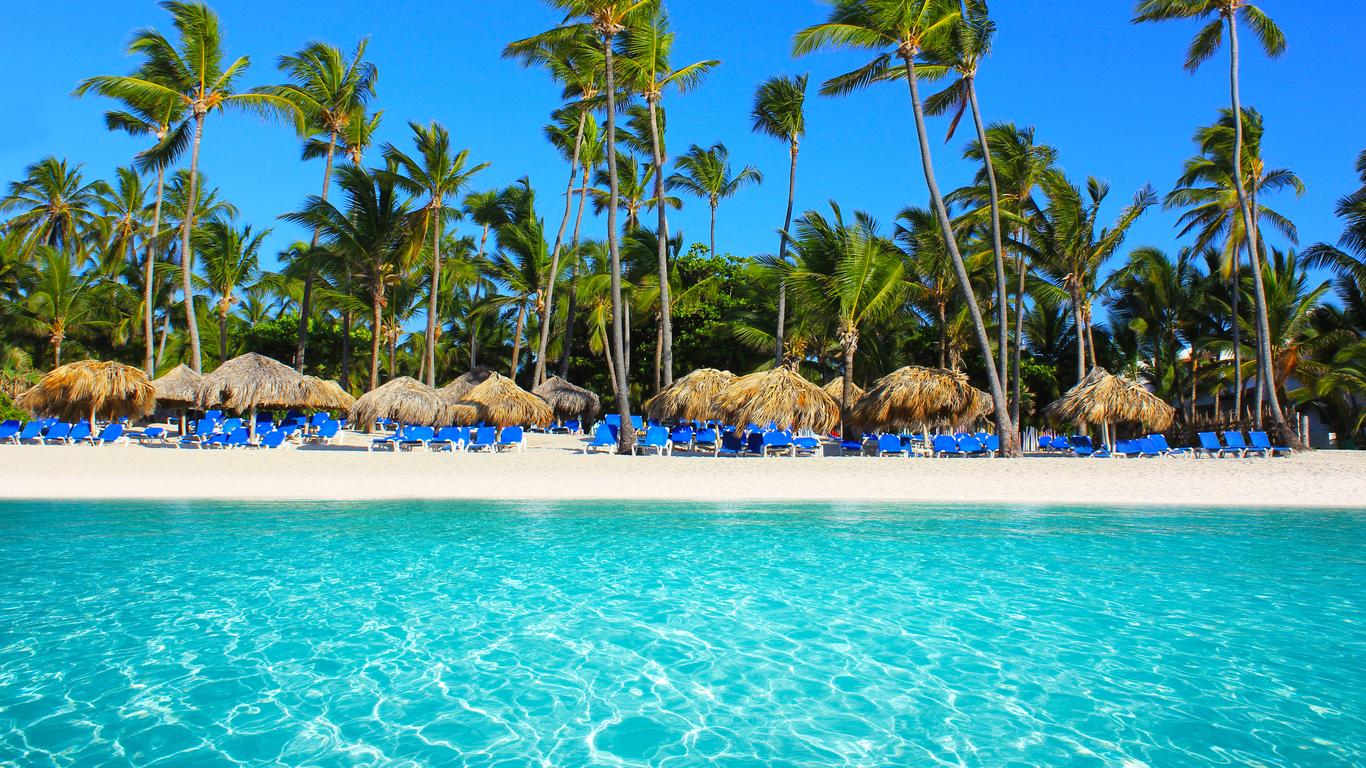
Find cheap flights to the Dominican Republic from $81
This is the cheapest one-way flight price found by a kayak user in the last 72 hours by searching for a flight from the united states to the dominican republic departing on 9/10. fares are subject to change and may not be available on all flights or dates of travel. click the price to replicate the search for this deal., search hundreds of travel sites at once for deals on flights to the dominican republic.
Save 21% or more Compare multiple travel sites with one search.
Track prices Not ready to book? Create a price alert for when prices drop.
Filter your deals Choose cabin class, free Wi-Fi and more.
Bundle and save Save money when you bundle your flight + hotel.
Best Dominican Republic Flight Deals
Cheapest round-trip prices found by our users on KAYAK in the last 72 hours
Good to know
Faqs - booking dominican republic flights, which dominican republic airport should i fly into when visiting santo domingo.
Santo Domingo, the Dominican Republic's capital, is the island's primary tourist area. When visiting the region, consider flying into Las Americas International Airport, about a 42-minute drive from the city center and 17-minute drive from Boca Chica beach. If the specific area in Santo Domingo is far from the airport, you can fly into SDQ and then take another method of transportation to your desired destination.
Can I rent a vehicle at Santo Domingo Airport?
Renting a vehicle will be ideal if you prefer private means of transit across the country. The international airports in the Dominican Republic offer vehicle rental services. If you are flying into Santo Domingo airport, you can access car rental agencies, including Avis, Budget, Dollar, Europcar, Hertz, Honda, National, Payless, Sixt, and Thrifty. The car rental agencies are in the arrivals hall of the north terminal.
What transportation can I get from Punta Cana Airport to the city center?
One of the best transit options from PUJ is a taxi. There are readily available fixed-rate taxis at the cab stands throughout the airport. Ensure you confirm the rates before starting the trip. You can also rent a vehicle at the airport from the on-site car rentals available. The airport is surrounded by hotels offering shuttle services to and from the airport for their guests. When checking a hotel, confirm that it provides a shuttle service from the airport. The most common transportation from the airport to the city center and other parts of the country is via bus. The buses leave at two-hour intervals beginning at 7 a.m. To ensure you get the bus if you are headed to far-off places, you can make a booking and then get to the bus stop at least an hour before departing.
Does Puerto Plata Airport have any lounges?
If you are flying into Puerto Plata airport and would like a place to relax after your flight, consider visiting the airport lounges. The airport has two lounges, Victorian Room and Salon Ambar, both located airside on level 1 of the terminal. To access either lounge, ensure you have a lounge membership program. You can also visit any of the lounges regardless of your flight class.
Do I need a visa to visit the Dominican Republic?
For US nationals, you’ll be required to present a valid passport upon entry to the Dominican Republic, after which you’ll be required to pay a small fee for your visa, or tourist card. These cards can be purchased for durations up to 90 days.
Are there nonstop flights to the Dominican Republic?
Flying to the Dominican Republic from most cities in the US will result in a layover; however, there are a few select cities in the US that offer nonstop routes to the Dominican Republic. Miami, Newark, Orlando and Fort Lauderdale all offer nonstop routes between the United States and the Dominican Republic.
Where should I fly into to visit The Haitises National Park?
To get to the park, you can fly into Punta Cana airport. After the flight, you can either rent a car or buy a ticket for a local bus to get from Punta Cana to The Haitises National Park.
I’m going to visit the northern Dominican Republic, where should I fly into?
Although there are a handful of airports in northern Dominican Republic, most of them don’t operate flights to or from the United States. To get to northern Dominican Republic, it is most convenient to fly into Santiago de los Caballeros, which puts you within reach of both inland and coastal northern Dominican Republic.
How long is the flight to the Dominican Republic?
An average nonstop flight from the United States to the Dominican Republic takes 4h 47m, covering a distance of 1606 miles. The most popular route is New York - Punta Cana with an average flight time of 3h 45m.
What is the cheapest flight to the Dominican Republic?
The cheapest ticket to the Dominican Republic from the United States found in the last 72 hours was $78 one-way, and $165 round-trip. The most popular route is New York John F Kennedy Intl to Punta Cana and the cheapest round-trip airline ticket found on this route in the last 72 hours was $243.
Which airlines fly to the Dominican Republic?
JetBlue, Qatar Airways & American Airlines fly the most frequently from the United States to the Dominican Republic.
What are the most popular destinations in the Dominican Republic?
Based on KAYAK flight searches, the most popular destination is Punta Cana (49% of total searches to the Dominican Republic). The next most popular destinations are Santo Domingo (29%) and Santiago de los Caballeros (18%). Searches for flights to Puerto Plata (4%), to Nagua (0.0%) and to La Romana (0.0%) are also popular.
How does KAYAK’s flight Price Forecast tool help me choose the right time to buy?
KAYAK’s flight Price Forecast tool uses historical data to determine whether the price for a given destination and date is likely to change within 7 days, so travelers know whether to wait or book now.
Top tips for finding cheap flights to the Dominican Republic
- Enter your preferred departure airport and travel dates into the search form above to unlock the latest Dominican Republic flight deals.
- The Dominican Republic has seven international airports. There are only three main airports, however: Punta Cana International Airport (PUJ), Las Americas International Airport (SDQ), and Puerto Plata International Airport (POP).
- If you are headed east of Dominican Republic, consider flying into Punta Cana International Airport (PUJ) as the airport is closer to that region. The airport serves large airlines such as British Airways, Delta, Southwest, and American Airlines. PUJ services more airlines than any other airport in the country.
- The Dominican Republic is strict about bringing pets to the island. You must ensure your cat or dog has a veterinary certificate with a maximum of up to 15 days and a microchip.
- If you are flying to Dominican Republic Santo Domingo in February, expect traffic on flights, especially Sundays, as the Dominican Carnival event takes place every Sunday in the capital city.
- If you want to connect to other islands around the Dominican Republic, flying into La Isabela International Airport (JBQ) is ideal. The airport is well connected to other Caribbean islands, hence it’s convenient for exploring the other islands.
- As you’re booking your flight to the Dominican Republic, you’ll likely notice that there are a handful of different cities available to fly into. Santo Domingo is the air hub in the Dominican Republic that receives the most international air traffic, but flights from the US also arrive in Santiago, Punta Cana, and a few other smaller airports.
- For exploring the southern part of the Dominican Republic, it can be beneficial to fly into the neighboring city of Port-au-Prince, Haiti. This city is located near the border of Haiti and the Dominican Republic and receives a high volume of international air traffic, unlike the Dominican airport that serves the same region.
- Dominican Pesos are the national currency of the Dominican Republic but select tourist areas around Punta Cana and select other tourist areas do accept US Dollars. If you’re traveling outside of these areas, check for ATMs in the airports, where you can use your American debit and credit cards to get Dominican Pesos.
- Getting to your accommodation after your flight to the Dominican Republic can range in difficulty depending on whether your hotel is in a remote location or not. Shuttles, city buses and public buses can get you around metropolitan areas, but a car rental is required for the more rural or off-the-beaten-path areas of the Dominican Republic.
- For travelers looking to extend their travels in Puerto Rico after flying into the Dominican Republic, you’ll have a few options for getting there. Flights from all major cities in the Dominican Republic can connect you with San Juan, and there is also a ferry that operates from Santo Domingo to San Juan.
Top 5 airlines flying to the Dominican Republic
Had to change aircraft due to a faulty door. Surprisingly it only caused about an hour and a half of delay. Delta handled this situation as well as can be expected.
Awful. Flight was continuously getting delayed and gates kept changing without any reason. Flight was delayed for more then 3 hours
Paid premium for Delta only to be on safe but tired old 767 with ancient cabin in mediocre condition. Poor wifi and horrible inflight entertainment. Hardly a premium experience. Should have flown SW and had fun flight crew and no pretense
Our flight to Zurich was delayed by almost 3 hours, so we missed our next flight. There was no indication it would be delayed this much. We were told the gate had changed and then it apparently took over 2 hours to load the "catering" on the plane. We were not compensated in any way for the trouble.
Rated entertainment as Mediocre as there were major problems with the Infotainment system that took probably a half hour for them to fix.
Your crew could maybe answer the call bell at least one of the times I pressed it. I pressed it first time with 2.5 hours left in our flight bc my partner was hungry and wanted a sandwich. We finally got the sandwich with 40 mins left in the flight.
Half the bathrooms assigned to economy were out of action
Delta crushed it. Flight attendant in first was attentive and just never stopped. Honestly one of the best domestic flights I’ve been on.
They were an hour late and they didn’t have my wheelchair for me
The Flight crew didn’t serve us until about 1.5 hours into the flight because of turbulence but after it ended it was fine to move around. They served us water only and snacks and then NEVER, NOT ONE TIME came through to collect trash until right before landing about 1.5 hours later. There was absolutely no need for that. They crew was just standing around talking and visiting with each other and really never tried to see if we might want something besides water or even try to come pick up trash. This is VERY unusual for a Delta flight but it was not what I would have expected for a 4 hour flight.
Great! I love Jet Blue. My favorite airline! Very efficient, clean and timely.
Run out of snack choices. Why are the seats not padded for your butt? Are we sitting on blocks of wood or metal for $250-300 a pop? This ain’t spirit. Let’s get it together people
We were told that our flight would be delayed for 90+ minutes because of weather, so we went to get something to eat only to have them randomly start boarding 15 minutes after the announcement, with no warning.
Entertainment... No earphones passed out. Many including me couldn't use the TV. Legroom was good. Crew was indifferent and a bit surly. Free wifi was a nice convenience. Check in desk location was unknown. Gate number on the boarding passes was wrong.
Going through JFK’s security is a mess. The TSA security said no shoes on the bins. So, we place our shoes in the belt and they came out all over the belt. Boarding was delayed and Flight as well.
Safe and on time were the positives. The plane wasn't cleaned before boarding, there was garbage and food on the floor and in the seat pocket. The TV screen was small and the picture fuzzy, audio quality was poor. Seatbelt was fraying and seat did not recline properly. No charging ports near the seats,
Confusing. Delay updates were out of whack At one point it said my flight was 25 hours. Three gate changes and two delays only to change back to original departure time. Gate announcer and on board flight attendant (Alejandro) making the announcements was impossible to understand due to accent and speed of speech. After beverage service the rear flight attendants sat back there on their phones. No refills no checking in, one sweep through for trash collection. Very impersonal. Bring back Coke products
Delayed departure. Delayed after landing pulling into gate. Delay due to sky bridge malfunction
Great. Loved that there was WiFi on flight to keep in touch and excellent service of beverages and snacks.
Business class is great. New airplane, very comfortable, better than some of the major airlines I am used to
Fine. Though no food or entertainment so the survey needs to be updated with those options.
Backpack should NOT allowed put in the flight bin , only put it under the seat. I can't find space put my carry on luggage!!! and I pay for it ! that was very bad experience
Fantastic. Smooth boarding with an infant. Never experienced it with any other carriers.
This was a flight operated by Lufthansa. See me prior comments, which were meant for this experience. The CSA, Ashley, should be reprimanded if not fired for incompetence, being rude, and very, very slow. She was whispering to other CSAs, blaming my flight change on others, unable to give me a seat assignment, telling me could not help without offering any advice (I travel 200,000 miles a year and am a consultant to the airlines, so I know how this gets done PRETTY DAMN WELL). Then, she gave me literally the worst seat on the airline (yes, there were other seats open) - the one right next to the bathroom that was so bad the other PAX next to me left to move to another seat. My seat kept getting rammed (3x) by the crew with their carts (no turbulence to speak of), other passengers grabbing the seat to get in or out of the bathroom, and listening to the bathroom flush all night.
This was a Lufthansa flight, not United. The CSA at the counter, Ashley, was not only incompetent, but quite rude. Me and two other PAX waited over 7 minutes standing in front of her and another CSA and they ignored us. We joked that we must have accidently taken invisibility pills. She could have at least said "I'll be with you in a moment, I'm currently....". I could go on about how rude she and the other CSAs were (whispering, not communicating with me, blaming the situation on others, etc.). She would not work for me. Then, she gave me literally the worst seat on the plane. the worst. My seat kept getting bumped (rammed twice by the crew with their carts and about every 5 minutes by someone using the bathroom), listening to the bathroom all night, crowded seat, etc.
My seat was broken. WiFi didn’t work. Gate crew at HOU were rude and condescending. Treated all the passengers badly. Bad experience, United.
First flight of the day… MINIMUM FUEL! 15 minute landing delay at HOU due to fog turned into a 2+ hour delay! Rather than circle, they had to divert to another city to refuel! Sat on tarmac at Austin to refuel. We ALL missed our connections! The crew, including pilots, were clueless. Crew was really a mess. At HOU, Untied employees were exceedingly rude to all. It was pitiful.
Food wasn’t very good, old business seating configuration on an old A340
An hour and a half late is UNACCEPTABLE. The negative impact to our family is unconscionable. And for the price we were forced to pay...
Standard flight experience, but there is only power at the seat to row 20 on the aircraft, on my initial check in it did not say that was the case
Was lucky to have a employee at the AA checkin counter that had compassion and understood they ordeal that we went through with our original flight being diverted, needing to stay in the aircraft and then flying to the original destination; adding hours to the trip and forcing us to miss our connection and our rebooked connection. She was able to get up on standby on the highest priority on the next flight to the closest airport we need to be at and it all worked out despite being many hours late.
Delayed so that missed connecting flight. Connecting flight was also delayed on the tarmac but they closed the gate before the rescheduled time.
Attendants were rude. Scowling. Seats were miserable and we paid extra.
Took off over an hour late with multiple mechanical issues. Gate agent in Dallas was lazy and was slow as molasses. Had a line 10 people long. Spirit bad..
The preferred seats where awful. Impossible to use them again
The flight was short. However, my bag was delayed and was put on another flight.
Flight attendant was incredible. Very efficient, friendly and pleasant. Patricia was one of the best I have ever seen. Please give her a big raise!
Delayed multiple times. Boarding was ok but getting off the aircraft was a mess. So disorganized with staff trying to help the elderly but completely blocking path for anyone else to move. Bathroom was disgusting, probably caused by one of the customers but staff couldn't care less to help clean it. No one wanted to use it since the floor was completely soaked so everyone just lined up the other restroom while the staff just chit chat with each other while looking at us.
LIT to DFW - 3 hours late; the entire plane had been boarded before they told us there was a delay due to a weather-related ground stop in Dallas. DFW to MAY - 2+ hours late due to A/C needing to be repaired after everyone had boarded, then when we finally reach the runway, the First Officer timed out and we had to taxi all the way back to the gate and wait for a new one. I arrived in New Orleans 5+ hours later than I should have. Return flights were completely cancelled; rebooked through the app to fly through CLT instead of DFW. MSY to CLT had no issues, but CLT to LIT was delayed 1.25 hrs because flight attendants had not arrived to the airport yet. At least they didn’t make us all sit on the plane to wait for them. I should have driven.
Tray table was filthy when I sat down. I needed to have someone come clean it because there was food and stains on it WiFi didn’t work after paying for in flight WiFi Food was terrible and was not filling at all Chicken was rubbery Flight attendant had an attitude, interrupted me and wasn’t able to answer basic questions about the food selection such as “does the chicken have red sauce in it”. If your flight attendants are not going to know what is in the meals so we can make an educated decision based on dietary restrictions, they shouldn’t be on the plane. My 1.5 year old niece was sleeping and dropped her binkie. I went on the ground under the chairs looking for it. It was at that time that she came up to me as I’m CLEARLY on all 4s with a flashlight and said “I need to get by”. I said one moment please I’m getting something from under the seat (while my head was literally under the seat). Her reply was “no you need to move now” and proceeded to almost push me out of the way. I looked up and all I saw was her toes under my eyes. When I looked in front of me, her private parts were inches away from my face. I then made a comment “you couldn’t waited 2 seconds?” and her response was, “no I need to use the bathroom”. I understand that and would never want to be the reason someone couldn’t get to the bathroom but I was under the seat. She could’ve gone around the other way instead of harassing me, basically placing her private parts on my head and borderline pushing me out of the way. You don’t pay (especially this much) for this deplorable experience. This was by far the worst experience I have ever had on American. I will be absolutely thinking twice and thrice about flying American Airlines again. I would rather pay more to fly delta because at least I know their WiFi will work and their flight attendants won’t have a terrible attitude for no reason, nor will they act the way this woman did. Unacceptable.
I got a one-way, last-minute nonstop flight from PDX to BWI for only $125. Yes, I got nicked $79 more for a checked suitcase and $89 more for the BIG SEAT option, but it was worth it, even with $4.50 for coffee and $10 for a snack (the latter no different than any other airline). The grand total was still less flying on any other airline.
It was the worst ever, i will be filing a lawsuit to get a refund. Our flight was delayed 4 hours so we would miss our connecting flight, we were not rebooked to our destination the same day, we were not offered any options to get home on the same day despite being clear that we absolutely cannot get stranded at night due to family, we were forced to book our own flights on a different airline to get home, and spririt is refusing a refund because our flight wasn't cancelled, only delayed. oh yeah, and they lost our luggage on the first part of the trip and you cannot get a hold of customer service when anything goes wrong, on hold for 30+ minutes. and their app breaks so you can't use that either.
This recognisable no-frills airline gets me from point-A to point-B. I was able to get to Chicago without stress. The checked baggage collection and reclaim could be improved.
The crew was the best and very accommodating I know you don't offer any complimentary items but water and coffee will not break the bank !!
My flight was cancelled!!! I had to spend 200.00 on another flight!!
The whole day was a nightmare. Flight extremely late. Boarding was a mess of a nightmare.
When we landed, they kept us on the plane for almost 25 minutes. Could do better.
worst trip ever Spirit lost our Baggs which were never put on the plane in Atlanta. 24 hours ago they are telling me now that the bags are still missing.
Never been on this flight as i had missed it due to delayed connecting flight
Horrible. Delays, no customer support and fake promises and everything. i am suffering to help as due to connecting flight getting missed no support on ground and customer support window is closed and we are sitting o ground without anything
Book Cheap Dominican Republic Plane Tickets
Recent round-trip flight deals, search by stops, search by airline, search by price, recent one-way flight deals, last minute flights to the dominican republic, last minute flight, train and bus deals, flights to the dominican republic, return flight deals:.
Dominican Republic - United States
Cabin classes:
Browse origins:.
- Flights »
- United States
Browse destinations:
- Worldwide »
- Caribbean »
- Dominican Republic
Cookies on GOV.UK
We use some essential cookies to make this website work.
We’d like to set additional cookies to understand how you use GOV.UK, remember your settings and improve government services.
We also use cookies set by other sites to help us deliver content from their services.
You have accepted additional cookies. You can change your cookie settings at any time.
You have rejected additional cookies. You can change your cookie settings at any time.
- Passports, travel and living abroad
- Travel abroad
- Foreign travel advice
Dominican Republic
Entry requirements.
This advice reflects the UK government’s understanding of current rules for people travelling on a full ‘British citizen’ passport from the UK, for the most common types of travel.
The authorities in the Dominican Republic set and enforce entry rules. If you’re not sure how these requirements apply to you, contact the Embassy of the Dominican Republic in the UK .
COVID-19 rules
There are no COVID-19 testing or vaccination requirements for travellers entering the Dominican Republic.
Passport validity requirements
An exemption is in place until 30 May allowing British passport holders to enter and leave the Dominican Republic as long as their passport remains valid for the duration of their visit.
Check with your travel provider that your passport and other travel documents meet requirements. Renew your passport if you need to.
You will be denied entry if you do not have a valid travel document or try to use a passport that has been reported lost or stolen.
Checks at border control
You may be refused entry if you do not have proof of onward or return travel when you arrive in the country.
Border officials will take your fingerprints and take a photograph of you before allowing you into the country.
Entry and exit form
You must fill in an entry and exit form before arriving in and leaving the Dominican Republic . This form includes your:
- customs declaration
- international boarding and disembarking form
You can fill in the form up to 7 days before you arrive in the country. You’ll get a QR code, which you may be asked to show at check-in, or when you arrive in or leave the country.
Visa requirements
You can visit the Dominican Republic for tourism without a visa for 30 days.
To stay longer (to work or study, for business travel or for other reasons), you must meet the Dominican Republic government’s entry requirements.
Extending your visit
You can pay to extend your visit up to 120 days by contacting the Dominican Republic Immigration Service .
Vaccine requirements
At least 8 weeks before your trip, check the vaccinations and certificates you need in TravelHealthPro’s Dominican Republic guide .
Depending on your circumstances, this may include a yellow fever certificate.
Children and young people
For children aged 17 and under travelling alone, parents should check travel requirements with the airline and with Dominican Republic Immigration Service .
Customs rules
There are strict rules about goods you can take into or out of the Dominican Republic (in Spanish). You must declare anything that may be prohibited or subject to tax or duty.
Related content
Is this page useful.
- Yes this page is useful
- No this page is not useful
Help us improve GOV.UK
Don’t include personal or financial information like your National Insurance number or credit card details.
To help us improve GOV.UK, we’d like to know more about your visit today. Please fill in this survey (opens in a new tab) .
Exploring The Beauty Of Traveling To The Dominican Republic
- Last updated May 28, 2024
- Difficulty Advanced
- Category Travel

Imagine yourself relaxing on a pristine, white sand beach, the crystal-clear turquoise waters gently lapping at your toes. Surrounding you are lush, tropical landscapes, vibrant with the colors of exotic flowers and towering palm trees. This is just a taste of the beauty that awaits you when you embark on a journey to the Dominican Republic. With its stunning natural landscapes, vibrant culture, and warm and welcoming people, this Caribbean paradise is a dream destination for any traveler seeking a true escape from the ordinary. Join us as we dive into the enchanting world of the Dominican Republic and discover the countless wonders that await you there.
What You'll Learn
Beautiful beaches: exploring the breathtaking coastline of the dominican republic, thrilling adventures: discovering exciting activities in the dominican republic, rich culture and history: dive into the vibrant heritage of the dominican republic, delicious cuisine: exploring the unique flavors of the dominican republic.

The Dominican Republic is known for its beautiful beaches and stunning coastline. With its crystal-clear waters, white sand beaches, and palm trees swaying in the breeze, it's no wonder that this Caribbean paradise is a top destination for beach lovers. If you're planning a trip to the Dominican Republic and want to explore its breathtaking coastline, here are a few must-visit beaches that you shouldn't miss.
- Punta Cana: Located on the eastern coast of the island, Punta Cana is famous for its picture-perfect beaches. The coastline stretches for miles, offering plenty of space for sunbathing, swimming, and water sports. You can also take a boat tour to nearby Saona Island, which is a secluded paradise with crystal-clear lagoons and pristine beaches.
- Playa Bavaro: Just north of Punta Cana, Playa Bavaro is another stunning beach that you shouldn't miss. It's known for its calm and shallow waters, making it perfect for swimming and snorkeling. With its powdery white sand and turquoise waters, Playa Bavaro is often listed as one of the best beaches in the Caribbean.
- Playa Rincon: Located on the Samana Peninsula, Playa Rincon is a hidden gem that's worth the trip. This secluded beach stretches for miles and is surrounded by lush green hills. The water here is incredibly clear and the beach is often deserted, giving you the feeling of having your own private paradise.
- Playa Macao: If you're a fan of surfing or bodyboarding, Playa Macao is the beach for you. Located on the northern coast of the island, this beach offers some of the best waves in the Caribbean. Even if you're not into water sports, Playa Macao is still worth a visit for its picturesque beauty.
- Playa Grande: Located in the Cabarete area, Playa Grande is a stunning beach with golden sand and turquoise waters. This beach is relatively untouched and lacks the crowds often found in other popular beach destinations. With its natural beauty and serene atmosphere, Playa Grande is perfect for relaxation and a quiet day at the beach.
- Las Galeras: Situated on the northeastern tip of the Samana Peninsula, Las Galeras is a picturesque fishing village with a stunning beach. The beach here is known for its powdery white sand and crystal-clear waters, making it ideal for swimming and snorkeling. You can also take a boat tour to nearby Paradise Island, where you can explore coral reefs and enjoy a secluded beach.
When exploring the breathtaking coastline of the Dominican Republic, be sure to pack sunscreen, beach towels, and plenty of water. Don't forget to bring your snorkeling gear if you plan on exploring the underwater beauty of the coral reefs. With its stunning beaches and clear waters, the Dominican Republic is truly a beach lover's paradise.
The Ultimate Guide: How to Travel from Munich Airport to Salzburg
You may want to see also
The Dominican Republic is a country known for its natural beauty, vibrant culture, and thrilling adventures. From exciting water sports to breathtaking hikes, this Caribbean paradise offers endless opportunities for adventure seekers. If you're planning a trip to the Dominican Republic and want to experience the most thrilling activities the country has to offer, here are some must-try adventures to add to your itinerary:
Kiteboarding in Cabarete:
Cabarete, located on the country's north coast, is known as the “kiteboarding capital of the Caribbean.” The combination of strong winds and calm waters creates the perfect conditions for this adrenaline-pumping sport. Whether you're a beginner or an experienced kiteboarder, there are plenty of schools and rental shops that offer lessons and equipment. Don't miss the chance to ride the waves and feel the wind in your hair!
Hiking the Pico Duarte:
If you're up for a challenge, hiking the Pico Duarte is a must. As the tallest peak in the Caribbean, reaching an elevation of 10,164 feet, this trek offers stunning vistas and a sense of accomplishment. The journey takes about four days round trip and includes camping in the beautiful mountainous landscape. You'll need to be physically fit and properly equipped, but the reward is definitely worth the effort.
White-water Rafting in Jarabacoa:
For thrill-seekers who love the rush of adrenaline, a white-water rafting trip in Jarabacoa is a must-do. This adventure takes you down the Yaque del Norte River, where you'll navigate through thrilling rapids and stunning canyons. Experienced guides lead the way, ensuring your safety while providing an exciting experience. It's a great way to cool off on a hot day and experience the natural beauty of the Dominican Republic.
Zip-lining in Samana:
Samana is a tropical paradise known for its lush rainforests and beautiful waterfalls. One of the best ways to explore this stunning region is by zip-lining. Soar through the treetops and get a bird's eye view of the stunning landscapes below. With several zip-lining tours available, you can choose from a range of options that cater to your level of adventure.
Scuba Diving in Bayahibe:
The crystal-clear waters of Bayahibe offer some of the best scuba diving in the Caribbean. Explore vibrant coral reefs, underwater caves, and abundant marine life as you dive into the depths of the ocean. Whether you're a certified diver or want to try an introductory dive, there are diving centers that cater to all levels of experience. Get ready to discover a whole new world beneath the surface!
These are just a few of the thrilling adventures you can experience in the Dominican Republic. With its diverse landscapes, welcoming locals, and abundance of activities, this country is a haven for adrenaline junkies and nature lovers alike. Embark on your own adventure and create unforgettable memories in this Caribbean paradise.
The Fate of Grant's Wife and Other Pregnant Travelers: Unveiling Their Mysterious Disappearances
The Dominican Republic is a country known for its rich culture and history. With its vibrant heritage, there are plenty of opportunities to dive into the various facets of Dominican culture. From exploring historical sites to immersing yourself in local traditions and customs, a trip to the Dominican Republic is sure to be an unforgettable experience.
One aspect of Dominican culture that stands out is its colonial past. The country was colonized by the Spanish in the 15th century, and many remnants of this era can still be seen today. Santo Domingo, the capital city, is home to the Colonial Zone, a UNESCO World Heritage site and the oldest European settlement in the Americas. Walking through the cobblestone streets of the Colonial Zone feels like stepping back in time, with its well-preserved Spanish architecture and historic buildings. Don't miss a visit to the Alcazar de Colon, the former residence of Christopher Columbus' son Diego, which now houses a museum showcasing artifacts from the colonial period.
Another way to explore the rich history of the Dominican Republic is by visiting its many museums. The Museo de las Casas Reales in Santo Domingo offers a comprehensive look at the country's colonial past, while the Museum of the Dominican Man provides a deeper understanding of the country's indigenous Taino culture. In Jarabacoa, the Centro Leon Cultural is a must-visit, with its exhibits on Dominican art, history, and culture.
In addition to its colonial history, the Dominican Republic also has a strong African influence. The country was a major hub for the transatlantic slave trade, and many African traditions have been preserved and incorporated into Dominican culture. One such tradition is the music and dance style known as merengue. Taking a merengue dance class or catching a live performance is a great way to experience this lively and energetic aspect of Dominican culture.
The Dominican Republic is also known for its vibrant festivals and celebrations. Carnival is the most famous of these, with colorful parades, music, and dancing taking over the streets. The celebrations culminate on February 27th, the country's Independence Day, with fireworks and parties all around. Semana Santa, or Holy Week, is another important celebration, with processions and religious commemorations taking place throughout the country.
To truly immerse yourself in Dominican culture, make sure to try the local cuisine. Dominican food is a delicious blend of African, Spanish, and indigenous flavors. Don't miss trying dishes such as sancocho, a hearty meat and vegetable stew, and mofongo, a mashed plantain dish often served with meat or seafood. Wash it all down with a refreshing glass of mamajuana, a traditional Dominican drink made with rum, red wine, and a variety of herbs.
When traveling to the Dominican Republic, it's important to respect and appreciate the local customs and traditions. Dress modestly when visiting religious sites, and always ask for permission before taking photos of people. Learning a few basic Spanish phrases will also go a long way in connecting with the locals and getting a deeper understanding of the culture.
Overall, a trip to the Dominican Republic offers a unique opportunity to dive into a vibrant and diverse culture with a rich history. From exploring colonial sites and museums to indulging in local food and traditions, there is something to captivate every traveler. So pack your bags and get ready for an unforgettable journey into the heart of the Dominican Republic's rich cultural heritage.
The Undying Motivation: What Drove Christopher Columbus to Continue Exploring
The Dominican Republic is not only known for its beautiful beaches and vibrant culture, but also for its delicious and diverse cuisine. With influences from Africa, Spain, and the indigenous Taino people, the food in the Dominican Republic is a unique blend of flavors and ingredients that will satisfy any food lover's taste buds.
One of the most iconic dishes in Dominican cuisine is the "mangu". This dish is made from mashed plantains, which are boiled and then mashed with butter. It is typically served for breakfast, accompanied by eggs, fried cheese, and fried salami. The combination of the creamy mangu with the savory toppings creates a delicious and filling dish that will energize you for the day ahead.
Another must-try dish is the "sancocho". This hearty stew is made with various meats such as beef, chicken, and pork, along with a medley of vegetables like yucca, plantains, and corn. The broth is flavored with herbs and spices, creating a rich and flavorful base. Sancocho is often enjoyed during special occasions and family gatherings, as it is the perfect comfort food to share with loved ones.
Seafood lovers will certainly be delighted by the variety of fresh fish and seafood available in the Dominican Republic. One popular dish is "pescado con coco", which is fish cooked in a coconut sauce. The fish is typically marinated in a mixture of lime juice, garlic, and spices, and then simmered in a creamy coconut sauce. The combination of the tangy marinade and the creamy coconut sauce creates a delightful harmony of flavors that will leave you craving for more.
For those with a sweet tooth, the Dominican Republic offers a wide array of delectable desserts. "Tres leches" cake is a favorite among locals and visitors alike. Made with three different types of milk (evaporated milk, condensed milk, and heavy cream), this cake is incredibly moist and indulgent. It is traditionally topped with whipped cream and cherries, adding a touch of sweetness and visual appeal.
To accompany your meal, it is essential to try the famous Dominican drink called "morir soñando". This refreshing beverage is a combination of orange juice and milk, with sugar and vanilla added for sweetness and flavor. The result is a creamy and tangy drink that is perfect for quenching your thirst on a hot tropical day.
As you explore the unique flavors of the Dominican Republic, be sure to venture beyond the tourist areas and seek out local eateries and street food stalls. These hidden gems often offer the most authentic and flavorful dining experiences. Don't be afraid to try new dishes and ask the locals for recommendations – they are usually more than happy to share their love for their traditional cuisine.
With its delicious and diverse culinary offerings, the Dominican Republic is a paradise for food enthusiasts. From the comforting mangu to the tantalizing pescado con coco, every dish brings a burst of flavors that will delight your taste buds. So, make sure to indulge in the unique and delectable cuisine of the Dominican Republic during your visit – your taste buds will thank you!
How to Redeem Your Bank of America Travel Rewards Points to Your Checking Account
Frequently asked questions.

- Melissa Carey Author Reviewer Traveller

- Jose Ramos Author Editor Reviewer Traveller
It is awesome. Thank you for your feedback!
We are sorry. Plesae let us know what went wrong?
We will update our content. Thank you for your feedback!
Leave a comment
Travel photos, related posts.

Uncover the Rich Cultural Heritage: A Guide to Traveling to Lijiang, China
- May 09, 2024

Exploring the Ancient Wonders: Discovering the Majestic Charm of Egypt
- May 28, 2024

Common Reasons Why Drivers Licenses are Invalid for Airport Travel
- May 20, 2024

Exploring the Sunshine State: Can I Travel to Florida in October?
- May 13, 2024

Exploring the World: Unveiling the Ease of Travelling With a Visa
- May 07, 2024

The Cost of Traveling by Wayshrine in ESO: What Players Should Know
- May 12, 2024
- La Altagracia Province Tourism
- La Altagracia Province Hotels
- La Altagracia Province Bed and Breakfast
- La Altagracia Province Vacation Rentals
- Flights to La Altagracia Province
- La Altagracia Province Restaurants
- Things to Do in La Altagracia Province
- La Altagracia Province Travel Forum
- La Altagracia Province Photos
- La Altagracia Province Map
- All La Altagracia Province Hotels
- La Altagracia Province Hotel Deals
- La Altagracia Province
- Things to Do
- Restaurants
- Vacation Rentals
- Travel Stories
- Rental Cars
- Add a Place
- Travel Forum
- Travelers' Choice
- Help Center
Weather - La Altagracia Province Forum
- Caribbean
- Dominican Republic
- La Altagracia Province
- United States Forums
- Europe Forums
- Canada Forums
- Asia Forums
- Central America Forums
- Africa Forums
- Caribbean Forums
- Mexico Forums
- South Pacific Forums
- South America Forums
- Middle East Forums
- Honeymoons and Romance
- Business Travel
- Train Travel
- Traveling With Disabilities
- Tripadvisor Support
- Solo Travel
- Bargain Travel
- Timeshares / Vacation Rentals
- Dominican Republic forums
- La Altagracia Province forum

- grand bahia principe resorts 11:48 am
- Resort that offers ONE level of service 8:35 am
- Opinions about security in Punta Cana? 8:35 am
- Seaweed! Beaches unusable 8:32 am
- Fishing charter punta cana Mike yesterday
- Weather yesterday
- Family Friendly Resorts similar to Club Med Punta Cana yesterday
- Hello, few questions about PC.. yesterday
- Looking for recommendation for Resort for 3 week stay. yesterday
- Iberostar Grand Bavaro yesterday
- Which beach is better for 10 days holiday May 26, 2024
- Jewel palm beach any questions May 26, 2024
- Taxis - Ubers May 26, 2024
- Best brands of coffee? 9 replies
- condo Santa Maria del Mar in Bavaro 11 replies
La Altagracia Province Hotels and Places to Stay
- Bavaro Express Bus Schedule
- Caribbean Travel Advisor
- Advertising
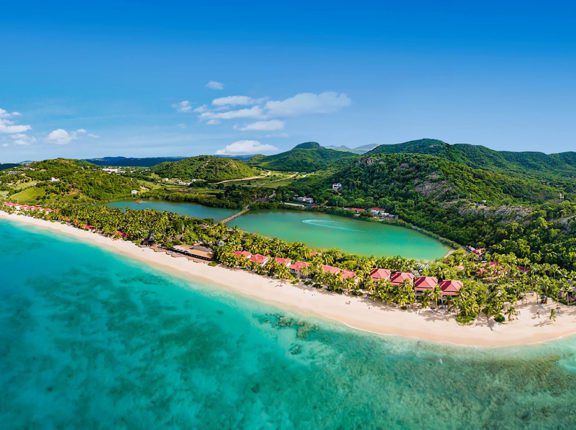
From All-Inclusive Resorts to Beaches, Travelers Are Falling in Love With Antigua and Barbuda

Dominican Republic on Track for 11 Million Total Visitors
Another month, another record. It’s been that kind of year for the Dominican Republic, the most-visited destination in the Caribbean and one that continues to see blazing tourism arrival numbers.
Last month, the Dominican Republic reached 4.178 million combined air and cruise visitors for the first four months of 2024 — putting the destination on track to exceed 11 million visitors in the calendar year.
That included just over 3 million air arrivals — a 10 percent jump compared to the first four months of 2024, according to Dominican Republic Tourism Minister David Collado.
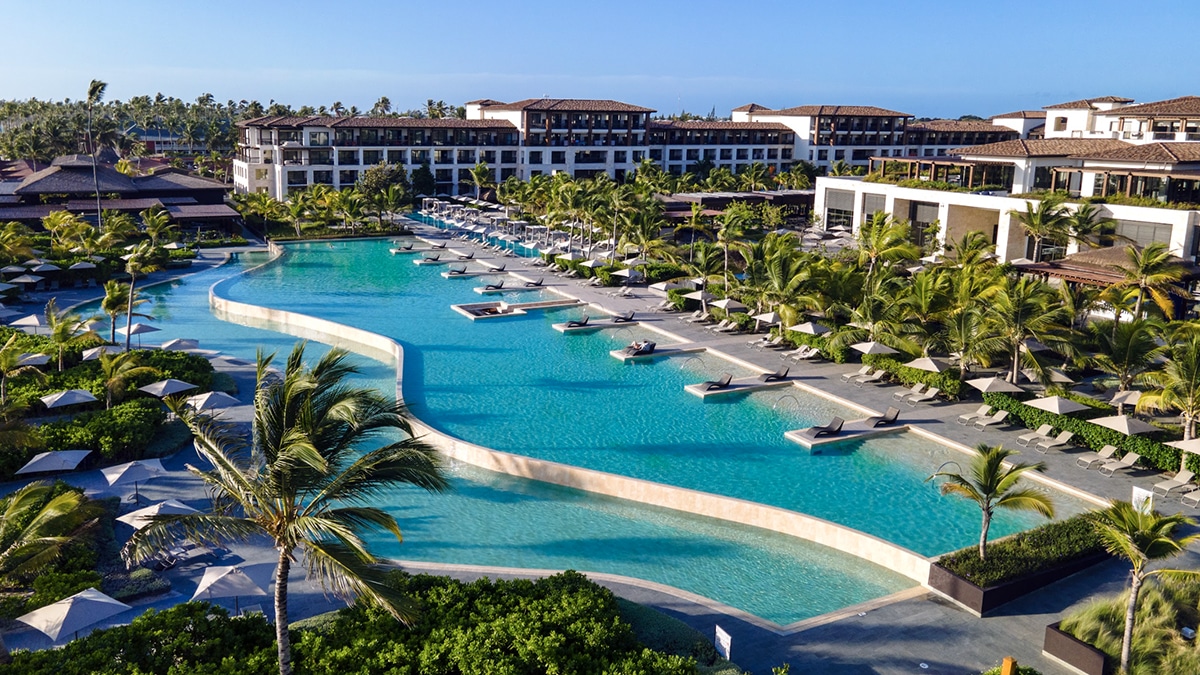
That’s also 24 percent compared to the country’s top pre-pandemic total in 2019.
The arrivals for 2024, unsurprisingly, constitute another record-breaking total for the country, Collado confirmed.
In April alone, the Dominican Republic reported just over 700,000 stopover arrivals, itself a 3 percent increase over 2023.
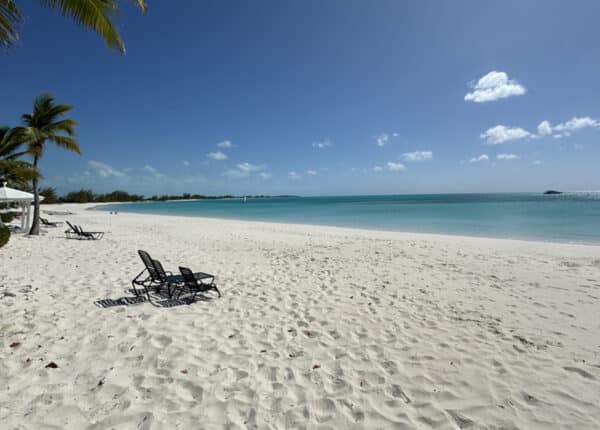
From Anguilla to Aruba, the Best Caribbean Beaches to Visit This Summer
Forget the Hamptons, forget Santorini. And Florida? There’s a reason snowbirds go home in the summer. If you’re looking for a summertime beach getaway, the Caribbean is it. The water is deliciously warm, the trade winds keep you cool and […]
From Belize to Grenada, 10 Little Caribbean Beach Resorts to Visit Right Now
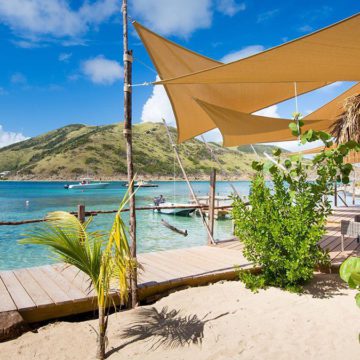
There are different resorts for different vacations, different tastes, different moods. For some, there’s something delicious about a pint-sized, tiny Caribbean resort, where the emphasis is on the intimate, the serene. Where the soundtrack isn’t a piped-in DJ set, but […]
Curacao Travel Is Booming, With More Hotels, Added Flights and a New Energy

The colorful streets of Willemstad; the floating bridge; the all-day party at Mambo Beach; the endless possibilities at Jan Thiel. Curacao has always been one of the most diverse places to visit in the region. Now, travelers have finally started […]
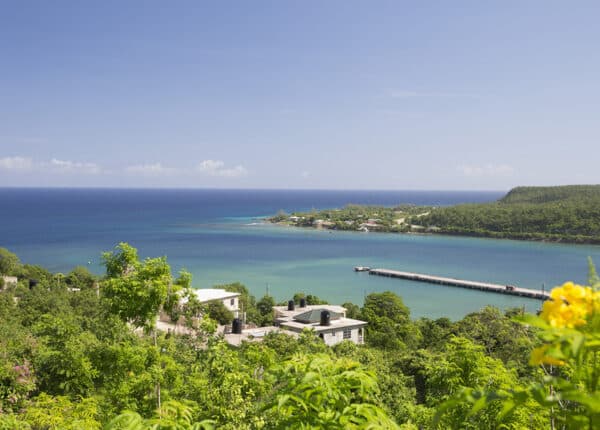
Jamaica’s Cruise Industry Is Growing, Buoyed by Royal Caribbean and Disney
Jamaica’s cruise industry is showing strong signs of growth, according to new numbers released by the country’s Ministry of Tourism. Last year, the island welcomed 1.26 million arrivals, up 48.3 percent compared to the previous year, according to Tourism Minister […]
Air Europa Is Adding More Nonstop Dominican Republic Flights

European low-cost carrier Air Europa is expanding in the Caribbean this summer, Caribbean Journal has learned. The company is adding a route to a new destination in the Dominican Republic: Santiago, which has quietly been seeing a wave of new […]
Princess Cruises Is Adding Another Caribbean Ship

Princess Cruises has another ship headed for the Caribbean this winter season. The new Sun Princess, what the company bills as its “newest and most innovative” ship, has already officially debuted in the Mediterranean ahead of its Caribbean winter. The […]
Sign up for Caribbean Journal's free newsletter for a daily dose of beaches, hotels, rum and the best Caribbean travel information on the net.

Dominican Republic 2024 Elections: What documents do you need to vote?
The Dominican Republic celebrates general elections this Sunday, May 19. Citizens will head to the polls to elect the country’s next president and vice president, as well as representatives in Congress.
Although different positions will be chosen, without a doubt, the presidential shortlist is the one that attracts the most attention.
A total of nine candidates are competing in the presidential race, including Luis Abinader of the Modern Revolutionary Party (Partido Revolucionario Moderno - PRM), Abel Martínez, of the Party of the Dominican Liberation (Partido de la Liberación Dominicana - PLD), Leonel Fernández of People’s Force (Fuerza del Pueblo - FP), and Miguel Vargas of the Dominican Revolutionary Party (Partido Revolucionario Dominicano - PRD).
The rest of the candidates include María Teresa Cabrera of the Broad Front (Frente Amplio - FA), Virginia Antares Rodríguez, of the Democratic Option (Opción Democrática - OP), Fulgencio Severino of the Fatherland For All Movement (Movimiento Patria Para Todos - MPPT), Pastor Carlos Peña Generation of Servants (Generación de Servidores - GS) and Roque Espaillat, of the Democratic Hope Party (Partido Esperanza Democrática - PED).
This year, 8,145,548 people are eligible to vote, including 7,281,763 Dominicans within the country and 863,785 abroad, mainly in the United States. We explain what is needed to vote.
What documents are needed to vote in the Dominican Republic elections?
Citizens who are registered on the electoral roll must go in person to cast their vote. In order to vote, they must present their current identity and electoral card. According to the Central Electoral Board (JCE), people with expired cards can participate in the elections.
Once you arrive at your voting center, the officials will confirm in the registry if you are authorized to vote and if so, they will give you three ballots with the letters “P”, “S” and “D”, which correspond to the Presidency, Senate and Provincial Representatives, respectively.
Here we explain in more detail how to vote from the United States or abroad .
This is how you can locate your voting center
The JCE has a tool where you can verify the precinct where you must go to vote . The only thing you have to do is enter your ID number and electoral college and check the box, then just click on the “verify precinct” option and the corresponding electoral college will appear. Voting hours are 7:00 a.m. until 5:00 p.m.
If no presidential candidate receives 50% +1 of the valid votes in the first round, a “second round” is held between the two candidates who obtained the most votes in the first round.
Remember that Sunday, May 19, 2024 is a non-working day for all citizens to vote. Additionally, starting from 7:00 a.m. on Saturday, May 18 until 5:00 a.m. on Monday the 20th the dry law will be imposed .


HOME ABOUT US ADVERTISING CONTACT
Last update on May 28, 2024, 11:19 am
World May 24, 2024 | 1:02 pm
Three American missionaries killed in Haiti orphanage attack

Haiti.- Three American missionaries were killed by armed bandits during an attack on an orphanage in Lison 49, Plaine, north of Port-au-Prince, which has been under the control of armed gangs for several months. This tragic incident was confirmed on Friday by the Missions organization in Haiti.
Two of the victims were Natalie Baker and her husband, Davy Lloyd, the daughter and son-in-law of Missouri state legislator Ben Baker. The legislator shared his heartbreak on social media, stating, “My heart is broken into a thousand pieces. I have never felt this kind of pain.”
Natalie and Davy were serving as missionaries in Haiti when they were attacked. The country has been engulfed in violence, with massacres, attacks, rapes, and kidnappings carried out by powerful armed gangs, a situation that has worsened since late February. Ben Baker added, “They went to heaven together. Please pray for my family, we desperately need strength. And please pray for the Lloyd family as well. I have no other words for now.”
No name has been released for the third victim who died alongside Davy and Natalie.
Former President and Republican presidential candidate Donald Trump also shared the news on social media, expressing his condolences and calling for action. “God bless Davy and Natalie. What a tragedy. Haiti is totally out of control. Find the killers NOW!!!” he wrote on Truth Social.
In March, the US State Department issued a travel advisory warning Americans against traveling to Haiti due to its “unpredictable and dangerous” security conditions.
Natalie and Davy were married in August 2022 and moved to Haiti three months later. They primarily worked with Haitian children through the NGO Missions in Haiti Inc., founded by Davy’s parents, David and Alicia Lloyd, in 2000.
In response to the escalating violence, the interim Government of Haiti announced on Wednesday an extension of the curfew for seven more days in the Oeste department, which includes the capital, Port-au-Prince. The state of emergency, extended from May 9 to June 8, aims to restore order and control amid high levels of insecurity caused by armed gangs.
To address the violence, a multinational security support mission, led by Kenya and endorsed by the UN, is expected to arrive imminently in Haiti. This mission aims to help curb the violence that resulted in approximately 8,000 deaths last year.
So who was the third victim?
Why Americans and foreigners continue to go to Haiti is beyond me.
They need to stay and help People in their own countries, no need to risk their lives in this dump.
Missionaries need to keep their Jesus cult among their own people and stop brainwashing poor black people with their nonsense. Or better yet, try that in muslim countries if you dare.
They are know Biblically to be wolf’s in sheep’s skin and false teachers …
These sects and cults are extremely dangerous, over 90+k are in full swing defrauding and doing all kinds of demonic things all over the globe for the all mighty buck …
The Dom Rep should be sending in military to help fight the gangs. It looks heartless especially when countries so far away such as Kenya are doing something. Even Jamaica and the Bahamas are sending armed forces. Why can’t the Dom Rep which is the next door neighbour?
You obviously are not educated on the history of the island. These are enemy countries who should not have any relations. Dominican military on Haitian soil is a no no. As for the Kenyans, they are paid mercenaries of the US and have no business being in Haiti. The only thing DR needs to do is break all relations with Haiti and seal its border.
May 17, 2024 | 9:22 am
CEMDOE expands services, reinforcing commitment to quality and safety in healthcare

May 16, 2024 | 8:43 am
WHO greenlights Japanese vaccine for Dengue prevention

May 14, 2024 | 10:25 am
Médico Express and Caribbean Health TPA foster medical tourism

May 13, 2024 | 9:34 am
Residents protest thermoelectric vessels in Azua

May 13, 2024 | 9:17 am
Ministry alerts public to Saharan dust arrival and health risks

May 10, 2024 | 2:16 pm
Bioanalysts union appeals to President Abinader for improved conditions

Bavaro & Punta Cana

- ADVERTISING
- Privacy Policies
- Cookies Policy
DominicanToday.com - The Dominican Republic News Source in English
Av. Abraham Lincoln N° 452 Local 220B, Plaza La Francesa, Piantini, Santo Domingo
Tel. (809) 334-6386

IMAGES
VIDEO
COMMENTS
Traveling to the Dominican Republic in June? Consider these itineraries. Dominican Republic Adventure: Santo Domingo & Samaná. Get the best of both worlds with this week-long itinerary. Start by seeing Santo Domingo's historic sights on a bike tour and then explore Santiago de los Caballeros (the DR's second city).
III. Busiest & Most Popular Months to Travel to the Dominican Republic December in the Dominican Republic. December is the most popular month for travel to the Dominican Republic, not just because tourists are flocking to our island to spend the holidays in the tropical weather but also because droves of Dominican families from the United States come back to see their families for our biggest ...
Low season is the best time for a bargain (June-November) Summer in the Dominican Republic means daily rainstorms and the start of hurricane season. It doesn't rain all day every day, but blazing temperatures mixed with frequent downpours contribute to soupy levels of humidity that most travelers are keen to avoid.
Call us in Washington, D.C. at 1-888-407-4747 (toll-free in the United States and Canada) or 1-202-501-4444 (from all other countries) from 8:00 a.m. to 8:00 p.m., Eastern Standard Time, Monday through Friday (except U.S. federal holidays). See the State Department's travel website for the Worldwide Caution and Travel Advisories.
Traveling to the Dominican Republic is a Visa-Free seamless experience for visitors from various countries, including the United States, Canada, the United Kingdom, the European Union, Russia, Ukraine, Kazakhstan, Mexico, many South American countries, Central America, Japan, Israel, and more. As of April 23, 2022, the travel landscape has ...
1. COVID Protocol for Traveling to the Dominican Republic. Long lines at a testing center during the holidays. The Dominican Republic is one of the most welcoming places to visit for tourism right now. There is no COVID-19 test needed to enter the country. And the Dominican Republic has ended all vaccine and mask mandates.
Reconsider travel to the Dominican Republic due to COVID-19. Read the Department of State's COVID-19 page before you plan any international travel. The Centers for Disease Control and Prevention (CDC) has issued a Level 3 Travel Health Notice for the Dominican Republic, indicating a high level of COVID-19 in the country. ...
How to See the Whales in Samaná Bay. If you're in the Dominican Republic between January 15 - March 25, try to make the trek north to see the whales in Samaná. After all, they've come some 3000 miles to see you. Read more. Humpback whale breaching in Samaná Bay. Photo: Kit Korzun / Shutterstock.com.
Anyone returning to the United States from The Dominican Republic must provide evidence of a negative PCR or Covid-19 test result obtained within three days prior to re-entry. Luckily, the ministry of tourism is offering PCR tests to all international visitors staying in a hotel. This service is provided to all international travelers coming ...
10. Using Uber in the Dominican Republic is a great way to avoid inflated prices. Uber operates in Santo Domingo, Santiago, and Puerto Plata, so if you're worried about being ripped off in a taxi, this is a great option. 11. There is such a thing as island time. Island time is alive and well in the Dominican Republic.
ESSENTIAL DOMINICAN REPUBLIC TRAVEL RESOURCES ... the island is still perfectly safe during June and July. Fall. With the coming of fall, the wet season reaches its peak. The temperatures are very high, and the number of rainy days per month is the highest in October (13 rainy days). The island is mostly tourist-free since it's also the peak ...
The Dominican Republic is the only destination in the region where 100% of the employees in the tourism sector are fully vaccinated with two doses, and which has the lowest incidence rate of contagion in the tourist poles, making the country a safe destination for travel.
The U.S. State Department last updated its travel advisory to the Dominican Republic on June 6, 2023. Since then, it remains at a Level 2, which encourages visitors to exercise increased caution. Many other popular tourist destinations have also been ranked at a Level 2 advisory, including Denmark, Costa Rica, Turks and Caicos, France, Germany ...
The Dominican Republic is a country full of fun cultural and entertainment traditions. Throughout the year, there are many local festivals in the island's different regions . Whether or not your trip coincides with one of these festivals or national events during the month of June, it's important to know that Punta Cana offers excellent ...
Most visitors arriving to the Dominican Republic-including those from the United States, Canada, United Kingdom, the European Union, Russia, Ukraine, Kazakhstan, Mexico, many South American countries, Central America, Japan, Israel-only need a valid passport to enter the country. The cost of the 30-day tourist card previously paid separately, is now included in the airline ticket.
Travel Advisory June 6, 2023. Dominican Republic - Level 2: Exercise Increased Caution. O D K E N H U T C. Reissued with updates to health information. Exercise increased caution in the Dominican Republic due to crime. Country Summary: Violent crime, including armed robbery, homicide and sexual assault is a concern throughout the Dominican ...
Unvaccinated travelers 60 years and older may get vaccinated before traveling to the Dominican Republic. Hepatitis B - CDC Yellow Book. Dosing info - Hep B. Malaria: CDC recommends that travelers going to certain areas of the Dominican Republic take prescription medicine to prevent malaria. Depending on the medicine you take, you will need to ...
3. Samaná is best for whale watching. The Samaná Peninsula is where the unspoiled natural beauty of the Dominican Republic mingles with friendly small-town sensibilities - a stark contrast to the glitzy resorts of Punta Cana and the bustling grind of Santo Domingo. The capital of this peninsular province is the eponymous Samaná, located in ...
Luckily, the weather is warm year-round, with average highs around 80 degrees Fahrenheit. But keep in mind: The Dominican Republic experiences some of the effects of the Atlantic hurricane season ...
The Dominican Republic has one of the highest road accident rates in the world. ... Your passport must be valid for a minimum of 6 months after the date of your arrival in the Dominican Republic. Passport for official travel. Different entry rules may apply. Official travel.
Cheapest round-trip prices found by our users on KAYAK in the last 72 hours. One-way Round-trip. Punta Cana nonstop $179. Santo Domingo nonstop $172. Santiago de los Caballeros nonstop $217. Puerto Plata nonstop $316. La Romana 2 stops $2,113. Nagua 1 stop $560.
Shoulder Season (May-June and September-November): These months are a great time to visit the Dominican Republic due to fewer crowds compared to the high season and less humidity and heat during ...
Before you travel. No travel can be guaranteed safe. Read all the advice in this guide and any specific travel advice that applies to you: women travellers. disabled travellers. LGBT+ travellers ...
You can visit the Dominican Republic for tourism without a visa for 30 days. To stay longer (to work or study, for business travel or for other reasons), you must meet the Dominican Republic ...
When traveling to the Dominican Republic, it's important to respect and appreciate the local customs and traditions. Dress modestly when visiting religious sites, and always ask for permission before taking photos of people. Learning a few basic Spanish phrases will also go a long way in connecting with the locals and getting a deeper ...
Subject: Security Alert - Worldwide Caution, May 20, 2024. Event: Due to the potential for terrorist attacks, demonstrations, or violent actions against U.S. citizens and interests, the Department of State advises U.S. citizens overseas to exercise increased caution. The Department of State is aware of the increased potential for foreign ...
La Altagracia Province forums. Peter D. 1 post. Weather. May 27, 2024, 3:17 PM. Travelling to Punta Cana on June 3rd for wifeys bday what's the weather like. Reply. Report inappropriate content.
Last month, the Dominican Republic reached 4.178 million combined air and cruise visitors for the first four months of 2024 — putting the destination on track to exceed 11 million visitors in ...
This year, 8,145,548 people are eligible to vote, including 7,281,763 Dominicans within the country and 863,785 abroad, mainly in the United States. We explain what is needed to vote. What ...
The first and only english language online news publication in the Dominican Republic. Providing local and international news, DR guides and access to real estate and car portals. ... the US State Department issued a travel advisory warning Americans against traveling to Haiti due to its "unpredictable and dangerous" security conditions ...